Unitech Electronics PA600BTGP Wireless Data Collection Terminal User Manual PDA PA600 II UM EN
Unitech Electronics Co., Ltd. Wireless Data Collection Terminal PDA PA600 II UM EN
Contents
- 1. User manual part 1 revise
- 2. User manual part 2
- 3. user manual part revise
- 4. user manual 2
user manual part revise
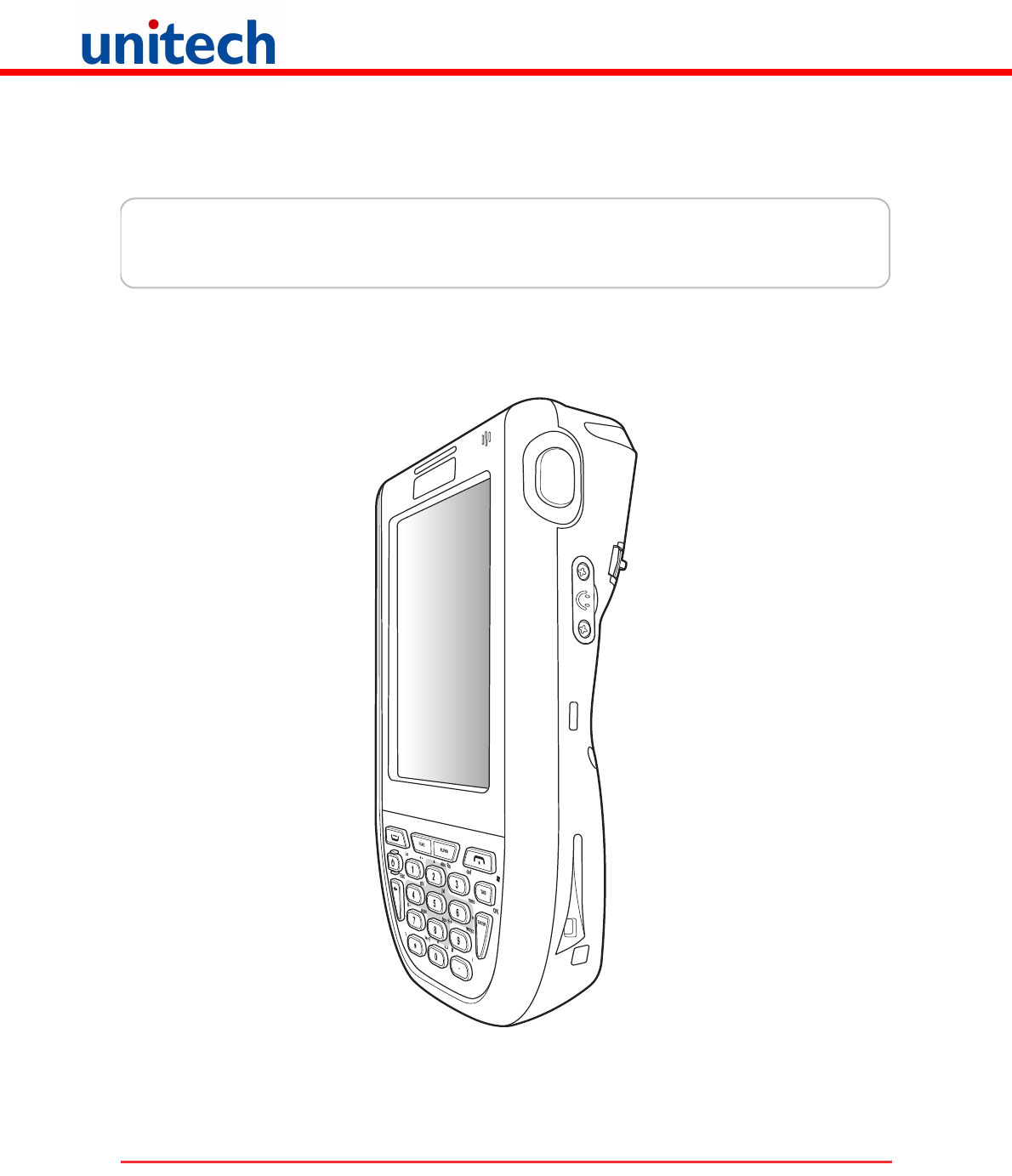
unitech
PA600 Phone Edition
User’s Manual
400646G Version 1.0

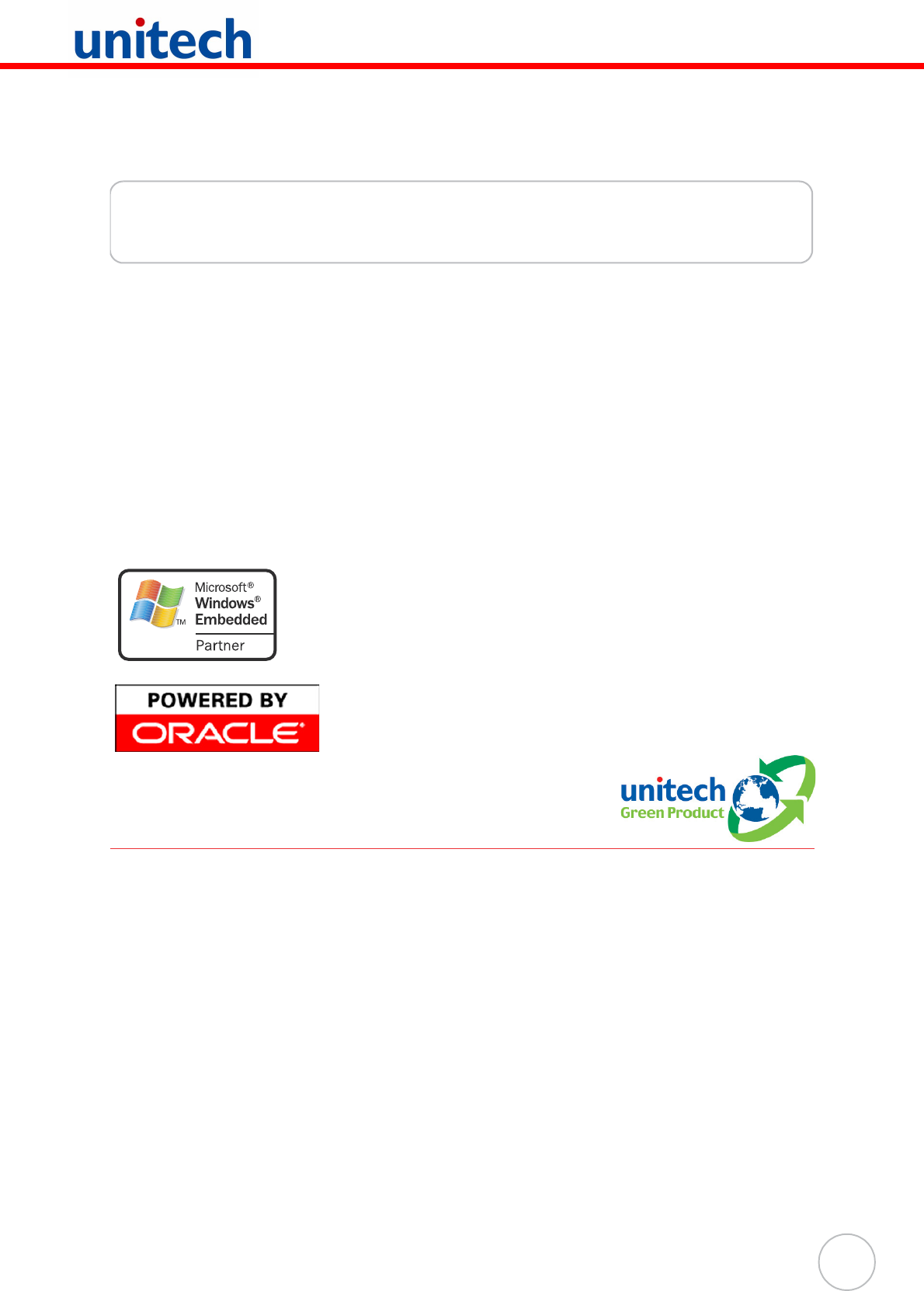
i
Preface
About This Manual
This manual explains how to install, operate and maintain the PA600 II Rugged Mobile
Computer.
No part of this publication may be reproduced or used in any form, or by any electrical
or mechanical means, without permission in writing from the manufacturer. This
includes electronic or mechanical means, such as photocopying, recording, or infor-
mation storage and retrieval systems. The material in this manual is subject to change
without notice.
© Copyright 2008 unitech Electronics Co., Ltd. All rights reserved.
unitech global website address: http:\\www.unitech-adc.com
Bluetooth is a registered trademark of Bluetooth SIG.
Microsoft, Windows and ActiveSync are either registered
trademarks or trademarks of Microsoft Corporation. Other
product names mentioned in this manual may be trademarks
or registered trademarks of their respective companies and
are hereby acknowledged.
unitech is a member of Oracle Embedded Software
Licensing Program.
Regulatory Compliance Statements
FCC Warning Statement
This equipment has been tested and found to comply with the limits for a Class B dig-
ital device, pursuant to part 15 of the FCC rules. These limits are designed to provide
reasonable protection against harmful interference in a residential installation. This
equipment generates, uses and can radiate radio frequency energy and, if not
installed and used in accordance with the instructions, may cause harmful interfer-
ence to radio communications. However, there is no guarantee that interference will
not occur in a particular installation. If this equipment does cause harmful interference
to radio or television reception, which can be determined by turning the equipment off
and on, the user is encouraged to try to correct the interference by one or more of the
following measures:
• Reorient or relocate the receiving antenna.
• Increase the separation between the equipment and receiver.

ii
• Connect the equipment into an outlet on a circuit different from that to which the
receiver is connected.
• Consult the dealer or an experienced radio/TV technician for help.
1. This equipment complies with FCC RF radiation exposure limits set forth for an
uncontrolled environment.
2. Any changes or modifications (including the antennas) made to this device that
are not expressly approved by the manufacturer may void the user’s authority
to operate the equipment.
FCC Label Statement
This device complies with part 15 of the FCC rules. Operation is subject to the follow-
ing two conditions:
1. This device may not cause harmful interference, and
2. This device must accept any interference received, including interference that
may cause undesired operation.
Canadian Compliance Statement
This Class B Digital apparatus meets all requirements of the Canadian Interference-
Causing Equipment Regulations.
Cet appareil numerique de la classe B respecte les exigences du Reglement sur le
material broilleur du Canada.
European Conformity Statement
Declaration of Conformity with Regard to the R&TTE 1999/5/EC and EMC 89/336/
EEC directives.
Taiwan NCC Warning Statement
國家通訊傳播委員會 (NCC) 低功率電波輻射性電機管理辦法 (930322)
根據 NCC 低功率管理辦法 規定:
第十二條 經型式認證合格之低功率射頻電機,非經許可,公司、商號或使用者均不
得擅自變更頻率、加大功率或變更原設計之特性及功能。
第十四條 低功率射頻電機之使用不得影響飛航安全及干擾合法通信;經發現有干擾
現象時,應立即停用,並改善至無干擾時方得繼續使用。前項合法通信,指依電信法
規定作業之無線電通信。低功率射頻電機須忍受合法通信或工業、科學及醫療用電波
輻射性電機設備之干擾。
為減少電磁波影響,請妥適使用!

About This Manual
iii
Laser Information
The unitech PA600 II series is certified in the U.S. to conform to the requirements of
DHHS/CDRH 21CFR Subchapter J and to the requirements of IEC 825-1. Class II and
Class 2 products are not considered to be hazardous. The PA600 II series contains
internally a Visible Laser Diode (VLD) whose emissions do not exceed the maximum
limits as set forth in the above regulations. The scanner is designed so that there is no
human access to harmful laser light during normal operation, user maintenance or
during prescribed service operations.
The laser safety warning label required by the DHHS/IEC for the PA600 II series's
optional laser scanner module is located on the memory compartment cover, on the
back of the unit.
CAUTION! Use of controls or adjustments or performance of procedures other
than those specified herein may result in hazardous laser light. Use of
optical instruments with the scanner will increase eye hazard. Optical
instruments include binoculars, microscopes, and magnifying glasses.
This does not include eye glasses worn by the user.
Battery Notices
This unit is equipped with a battery pack and backup battery. Both batteries will dis-
charge after an extended period of not being used.
When both batteries are discharged, recharge the unit for 16 hours in order to fully
charge the main battery and backup battery. There are two ways to recharge PA600
II:
1. Plug the USB charging cable to the PA600 II and plug the 5V/3A AC-DC
adapter to the power jack of the USB charging cable.
2. Place the PA600 II into the docking station and plug the 5V/3A AC-DC adapter
to the power jack of the docking station.
For more details, refer to page 8, Charging the Battery.
If the main battery is removed, the backup battery ensures the data on SDRAM is safe
for up to 2 hours. To prevent data loss, do not leave the PA600 II uncharged with the
main battery removed for an extended period.
Battery charge notice
It is important to consider the environment temperature whenever you are charging
the Lithium-Ion battery pack. The process is most efficient at normal room tempera-
ture or slightly cooler. It is essential that you charge batteries within the stated range of
10°C to 45°C. Charging batteries outside of the specified range could damage the bat-
teries and shorten their charging life cycle.

iv
Storage and safety notice
Although charged Lithium-Ion batteries may be left unused for several months, their
capacity may be depleted due to build up of internal resistance. If this happens they
will require recharging prior to use. Lithium-Ion batteries may be stored at tempera-
tures between -20°C to 60°C, however they may be depleted more rapidly at the high
end of this range. It is recommended to store batteries within normal room tempera-
ture.

v
Table of Contents
Preface
About This Manual i
Regulatory Compliance Statements ............................................................................. i
FCC Warning Statement.......................................................................................................... i
FCC Label Statement .............................................................................................................. ii
Canadian Compliance Statement ............................................................................................ ii
European Conformity Statement ............................................................................................. ii
Laser Information ................................................................................................................ iii
Battery Notices ..................................................................................................................... iii
Battery charge notice.............................................................................................................. iii
Storage and safety notice ....................................................................................................... iv
Chapter 1
Getting Started 1
Introducing the PA600 II ................................................................................................... 1
Features................................................................................................................................... 2
Package Contents ............................................................................................................... 3
A Tour of the PA600 II........................................................................................................ 3
Front Left View........................................................................................................................ 4
Back View ............................................................................................................................... 5
Getting Started...................................................................................................................... 6
Installing the Battery ............................................................................................................... 6
Charging the Battery............................................................................................................... 8
Charging the Battery using the USB Cable ....................................................................... 8
Charging the Battery with the Docking Station .................................................................. 9
Checking the Battery Status .............................................................................................. 9
Connecting the PA600 II to a PC.......................................................................................... 10
Turning the PA600 II on for the First Time............................................................................ 11
Powering On.................................................................................................................... 11
Calibrating the PA600 II Screen ...................................................................................... 12
Chapter 2
Using the Hardware 14
Keypads and Function Buttons ................................................................................... 14
Adjusting the Screen Brightness................................................................................ 16
Using the Stylus................................................................................................................. 16
Using the SD/MMC memory card ................................................................................ 17
Inserting a Storage Card ................................................................................................. 17
Removing a Storage Card ............................................................................................... 17
Using the Laser Scanner ................................................................................................ 18
Using the SIM Card ........................................................................................................... 19
Inserting the SIM Card..................................................................................................... 19

vi
Using the Phone................................................................................................................. 20
Making a Call Using the Phone Keypad ............................................................................... 21
Using the Contact List........................................................................................................... 21
Using the Speed Dial ............................................................................................................ 22
Customizing the Phone Settings........................................................................................... 22
Chapter 3
Getting Connected 23
Establishing Device-PC Connection.......................................................................... 23
Installing Microsoft ActiveSync ............................................................................................. 23
Connecting the Device to Your Computer ............................................................................ 26
Synchronizing with Your Computer........................................................................... 27
Connection options ............................................................................................................... 27
USB Connection .............................................................................................................. 27
Bluetooth Connection ...................................................................................................... 27
GPRS Connection ........................................................................................................... 30
WiFi Connection .............................................................................................................. 31
Synchronizing Information ............................................................................................ 35
Synchronization Options....................................................................................................... 35
Using ActiveSync to Exchange Files ........................................................................ 35
Chapter 4
Barcode Scanner Programs 37
Scanner Setting.................................................................................................................. 37
Scan2Key .............................................................................................................................. 37
Barcode Symbologies........................................................................................................... 38
Chapter 5
Advanced Settings 39
Adjusting Settings............................................................................................................. 39
Checking the Main and Backup Battery Status..................................................... 40
Extending Battery Life..................................................................................................... 41
Changing the Automatic Power Settings .............................................................................. 41
Adjusting Backlight Setting ................................................................................................... 42
Viewing Flash Memory Files ......................................................................................... 43
Performing a hardware reset ........................................................................................ 44
Performing a Warm Boot ...................................................................................................... 44
Performing a Cold Boot ........................................................................................................ 45
Performing a Clean Boot ...................................................................................................... 46
Appendix
System Specifications 47
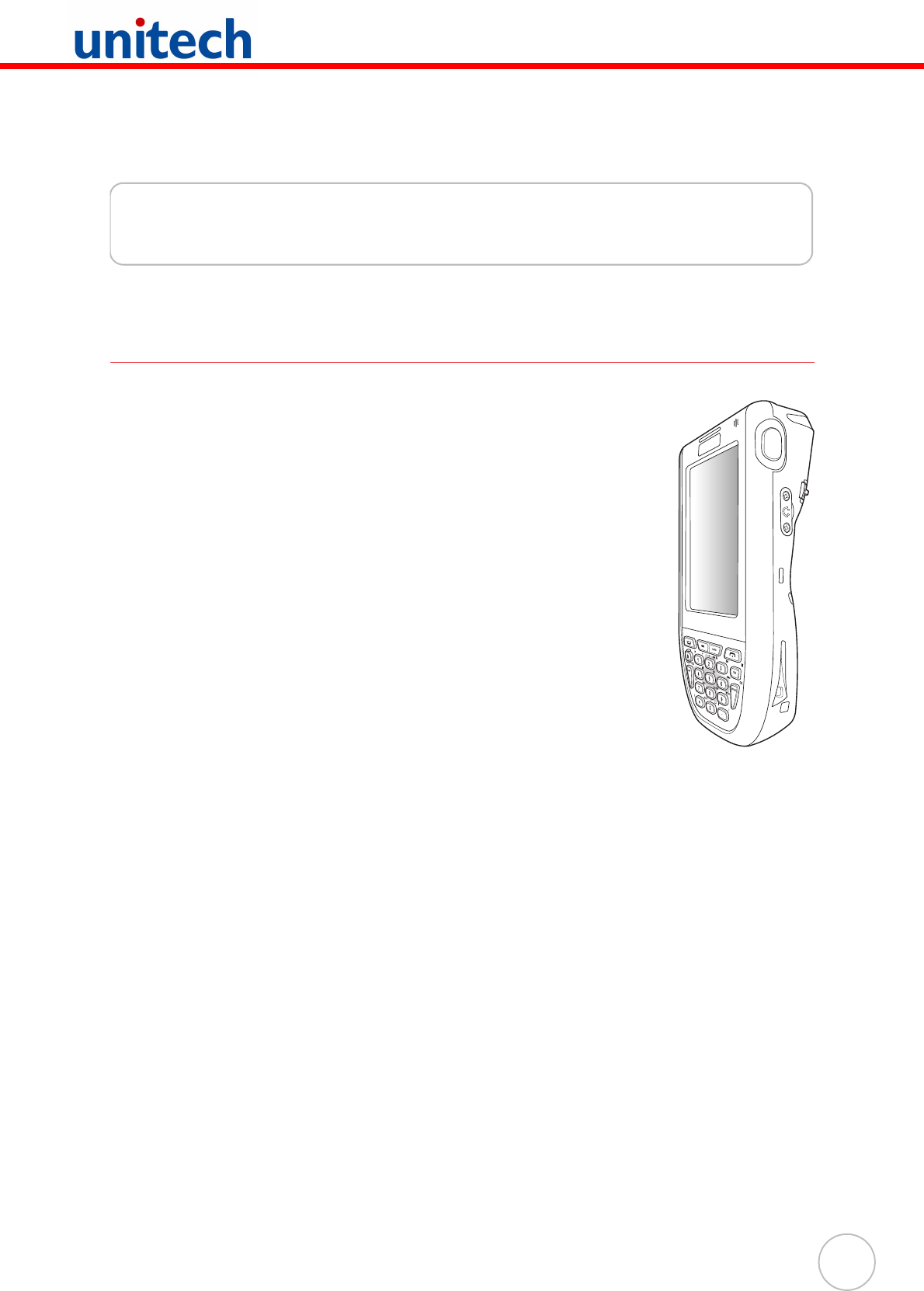
1
Chapter 1
Getting Started
Introducing the PA600 II
Thank you for purchasing the PA600 II Rugged Mobile Computer.
Your PA600 II was designed for users who need a compact and
durable PDA for data collection and real time transactions.
The PA600 II is a rugged, compact and lightweight palm-size com-
puter using the Windows Mobile 5.0 operating system, and incorpo-
rating an integral bar code scanning laser device, cell phone
function, color LCD with touchscreen, keypad, and wireless com-
munication capability. It provides users with a standard Windows-
based environment for customizing and operating the device.
To reduce TCO, the PA600 II is sealed to meet IP64 standards and
has undergone multiple drop tests to prevent downtime.

Chapter 1 Getting Started
2
Copyright 2008 unitech Electronics Co., Ltd. All rights reserved. unitech is a registered trademark of unitech Electronics Co., Ltd.
Features
Powerful system
• Microsoft Windows MobileTM 5.0
operating system
• Intel PXA270 processor with speed
of up to 624 MHz
System memory
• 128 MB SDRAM
• 320 MB Flash ROM
Display
• 3.5-inch QVGA TFT-LCD with
touch screen and backlight
• 240 x 320 resolution
Barcode scanner
• Built-in laser scan engine
• Built-in vibrator for scanning indi-
cation
• Symbol SE950 support
• Unitech Hamster barcode decoder
Communication
• USB Host & Client
• Bluetooth 2.0 + EDR
(supports Bluetooth Printer,
Bluetooth Modem, Bluetooth
ActiveSync)
• eGPRS Siemens MC75 Radio
Module, quad-band GSM 850/900/
1800/1900 MHz
– EDGE Multislot Class 10
– GPRS Multislot Class 12
– GSM Release 99
Audio
•MIC
• Speaker
• Headset Connector
• Receiver
Wireless connectivity
• 802.11b/g with diversity antenna
• Bluetooth wireless technology
Expansion slot
• Secure Digital (SD) card slot (sup-
ports SDHC up to 4G)
Battery life
• Operation time: typical 5 hours
(with Wifi), average 9 hours (w/o
Wifi)
• Charging time: under 5 hours
• Embedded backup battery cell
User-friendly interface
• Quick launch hot keys for enabling
backlight, calibration, phone calls,
software keyboard, and other
device management tasks
• Trigger keys for barcode scanning
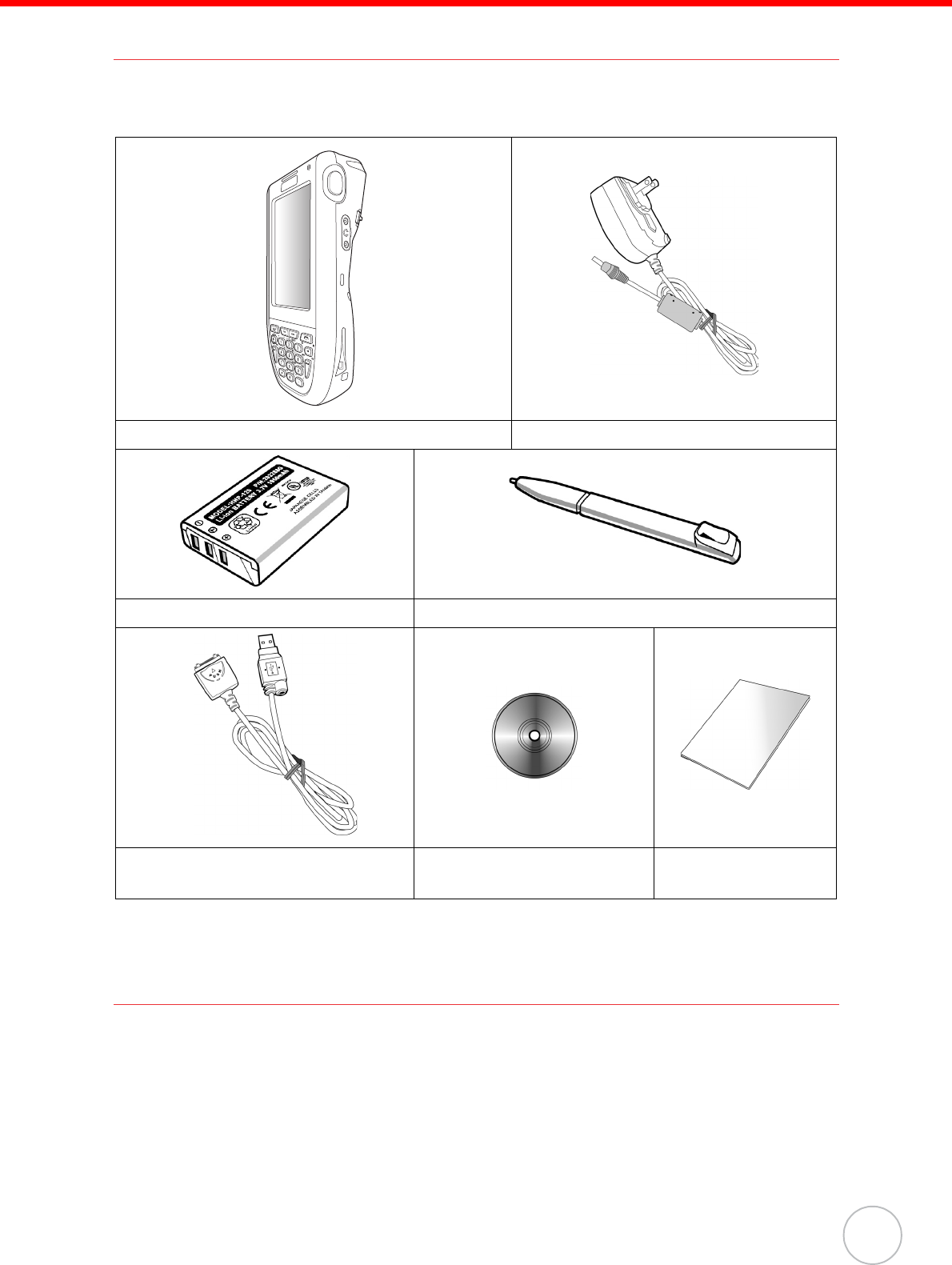
Chapter 1 Getting Started
3
Package Contents
After opening the box, ensure the following accessories for the PA600 II are present:
If anything is missing or appear damaged in any way, contact your dealer.
A Tour of the PA600 II
The following sections describe the main components and features of the PA600 II.
PA600 II Terminal AC Adapter with universal plugs
Battery Pack Stylus
USB Charging Cables CD-ROM Quick Reference
Guide
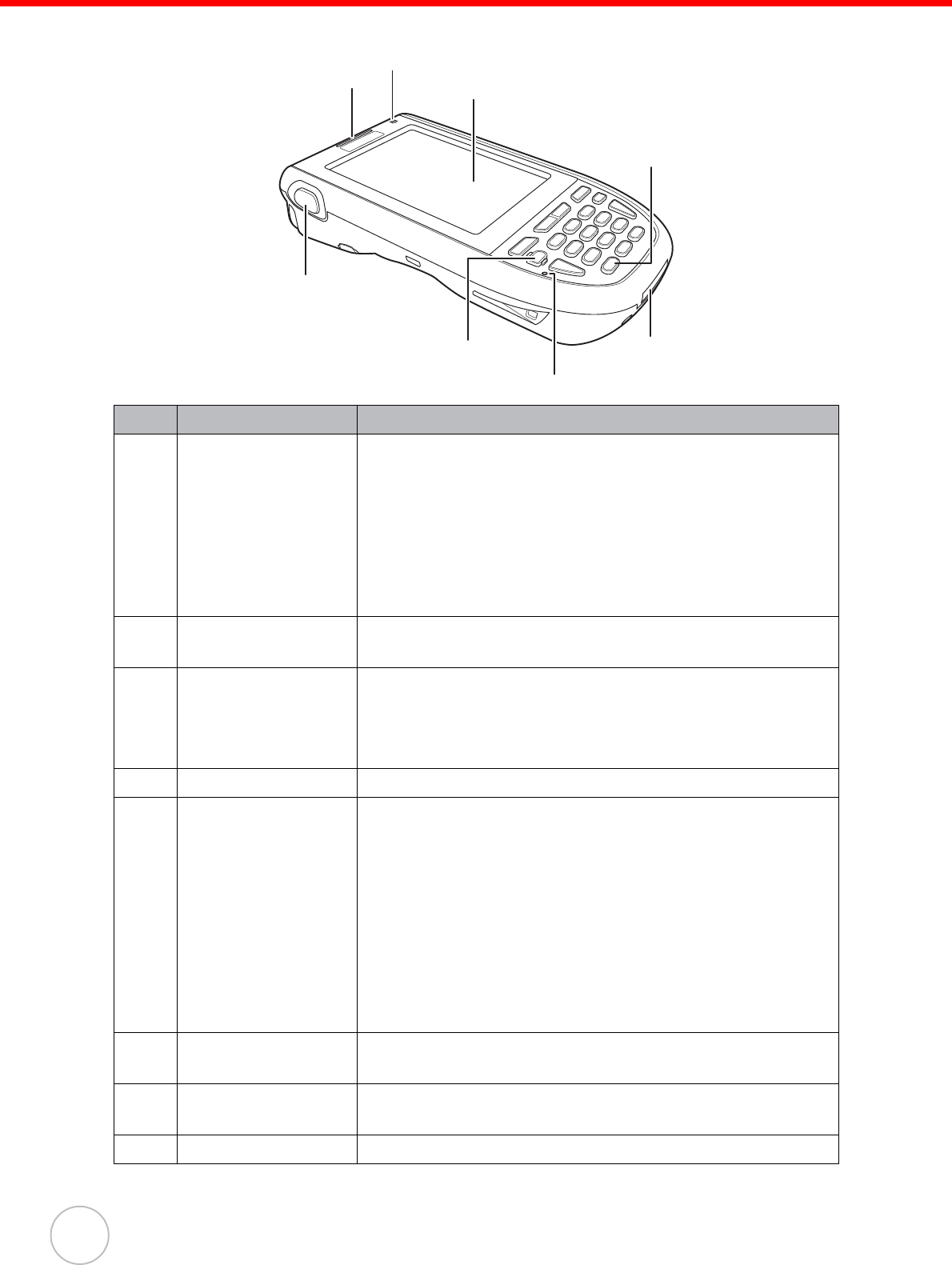
Chapter 1 Getting Started
4
Copyright 2008 unitech Electronics Co., Ltd. All rights reserved. unitech is a registered trademark of unitech Electronics Co., Ltd.
Front Left View
No. Component Description
1. Status indicator Indicates the battery charging and barcode scanning status.
Green - Battery is fully charged, or barcode
scanning process is completed without error.
Red - Battery is charging, barcode scanner is fired/
activated.
Yellow - GPRS is on
Blue - Bluetooth is on
2. Left scanner
trigger button
Press to activate the barcode laser scanner.
3. Power button If the device is off, press this button to turn it on.
Alternatively, when the unit is on, this key must be
pressed and held down for about three seconds in
order to turn the device off.
4. Microphone Enables you to record voice audio.
5. Universal
connector
Connects your device to a USB charging/
communication cable. This USB cable connects to the
computer’s USB port and accepts the 5V AC adapter
to provide power to the PA600 II.
This unit can simultaneously recharge and perform an
ActiveSync operation. You can also use it to connect
peripheral hardware, such as a docking station, to your
device. This port can also support USB and RS232
hosting for devices such as a USB or RS232 scanner,
keyboard, or USB memory key.
6. Keypad Keypad interface for controlling the PA600 II. See Keypads
and Function Buttons on page 14 for more information.
7. LCD touch screen Displays the applications and data stored on your device. It
is touch-sensitive and responds to the stylus or finger.
8. Speaker Enables you to hear audio from the PA600 II.
1
8
7
6
5
2
4
3
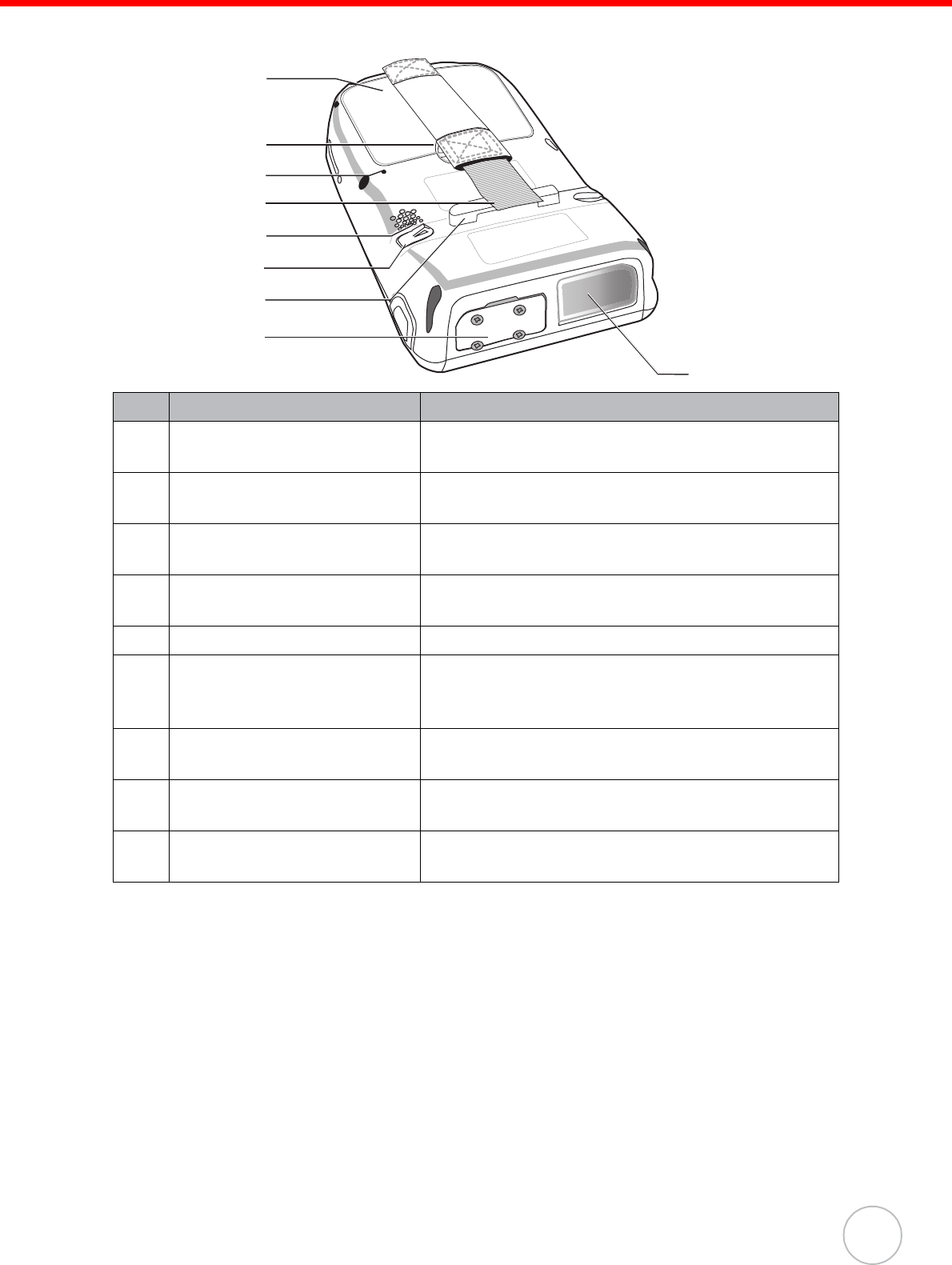
Chapter 1 Getting Started
5
Back View
No. Component Description
9. Battery compartment Houses the removable and rechargeable 3.7 V,
2200 mAH battery pack
10. Battery compartment
release latch
Opens the battery compartment.
11. Reset button Press the end of the stylus into the button to
reset your device.
12. Handstrap Enables you to securely hold the PA600 II while
using it.
13. Speaker Enables you to hear audio from the PA600 II.
14. Stylus Enables you to interact with the operating system.
To use the stylus, remove it from its holder and
hold it the same way as you hold a pen or pencil.
15. Strap holder Attachment location for holding hand strap,
carrying strap, and stylus.
16. Memory card slot Accommodates Secure Digital (SD) memory
cards and can serve as an SDIO port.
17. Barcode scanner window Scan barcodes window where the laser pass
through.
9
10
11
13
15
14
12
16
17
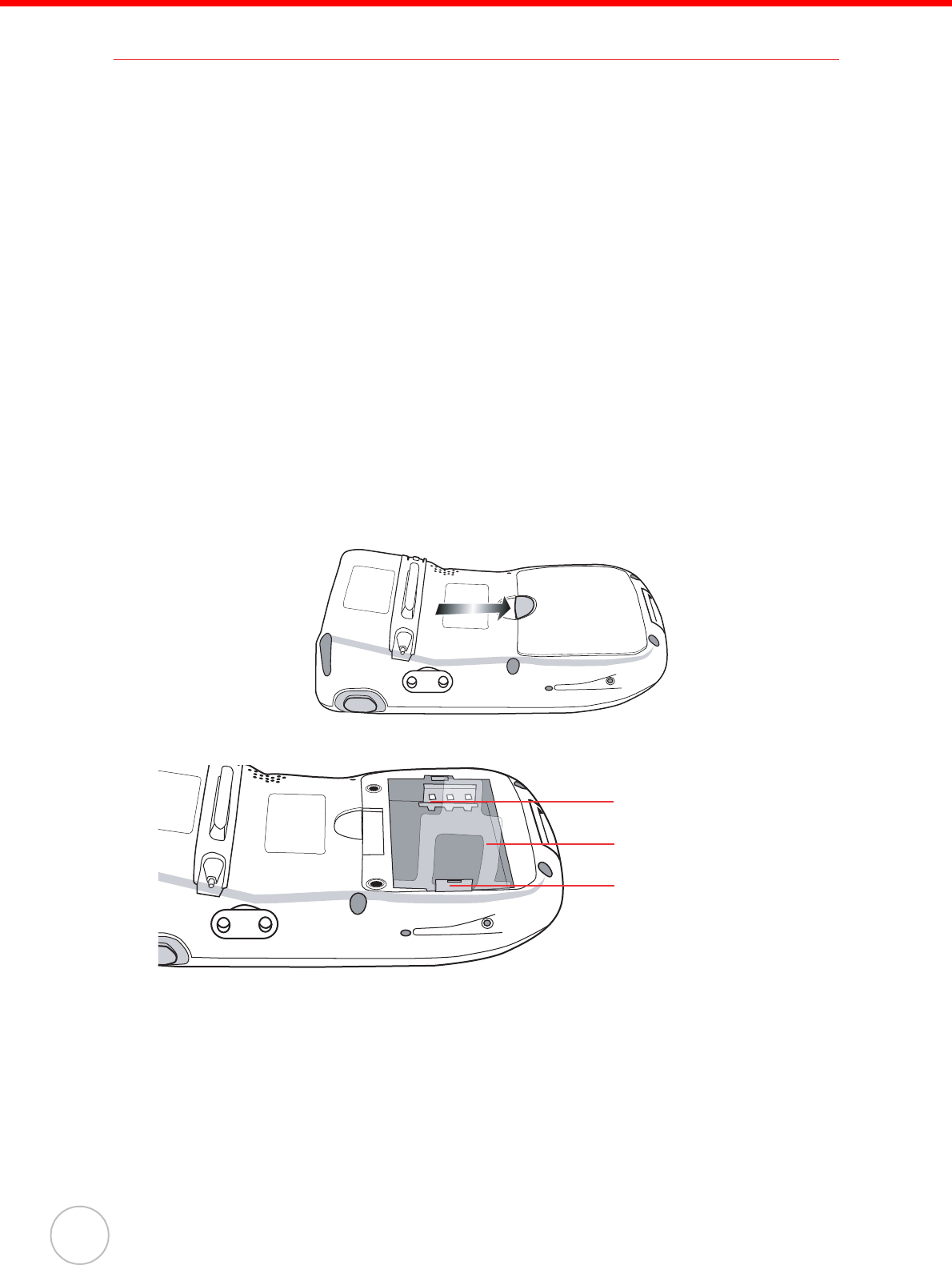
Chapter 1 Getting Started
6
Copyright 2008 unitech Electronics Co., Ltd. All rights reserved. unitech is a registered trademark of unitech Electronics Co., Ltd.
Getting Started
This section explains how to install and charge the battery, how to check battery sta-
tus, how to turn on the PA600 II, and how to calibrate the screen.
Installing the Battery
WARNING! There is a risk of fire and burns if the battery pack is handled improp-
erly. DO NOT disassemble, crush, puncture, short external contacts,
or dispose the battery pack in fire or water. DO NOT attempt to open
or service the battery pack. Dispose of used batteries according to
local recycling guidelines in your area.
A backup battery cell is embedded into your device to prevent data loss in instances
when the removable battery pack is removed or completely discharged. This backup
battery cell will keep the data and system setting for up to 6 hours if the main battery is
removed.
NOTE: To enable the internal battery cell to provide backup power supply,
charge your device with the main battery pack for at least 16 hours.
1. Open the battery compartment by pushing the latch in the direction of the arrow
and lifting up.
The battery compartment is displayed:
NOTE: The plastic battery tab makes it easy to remove the battery.
Compartment contacts
Plastic battery tab
Battery hook
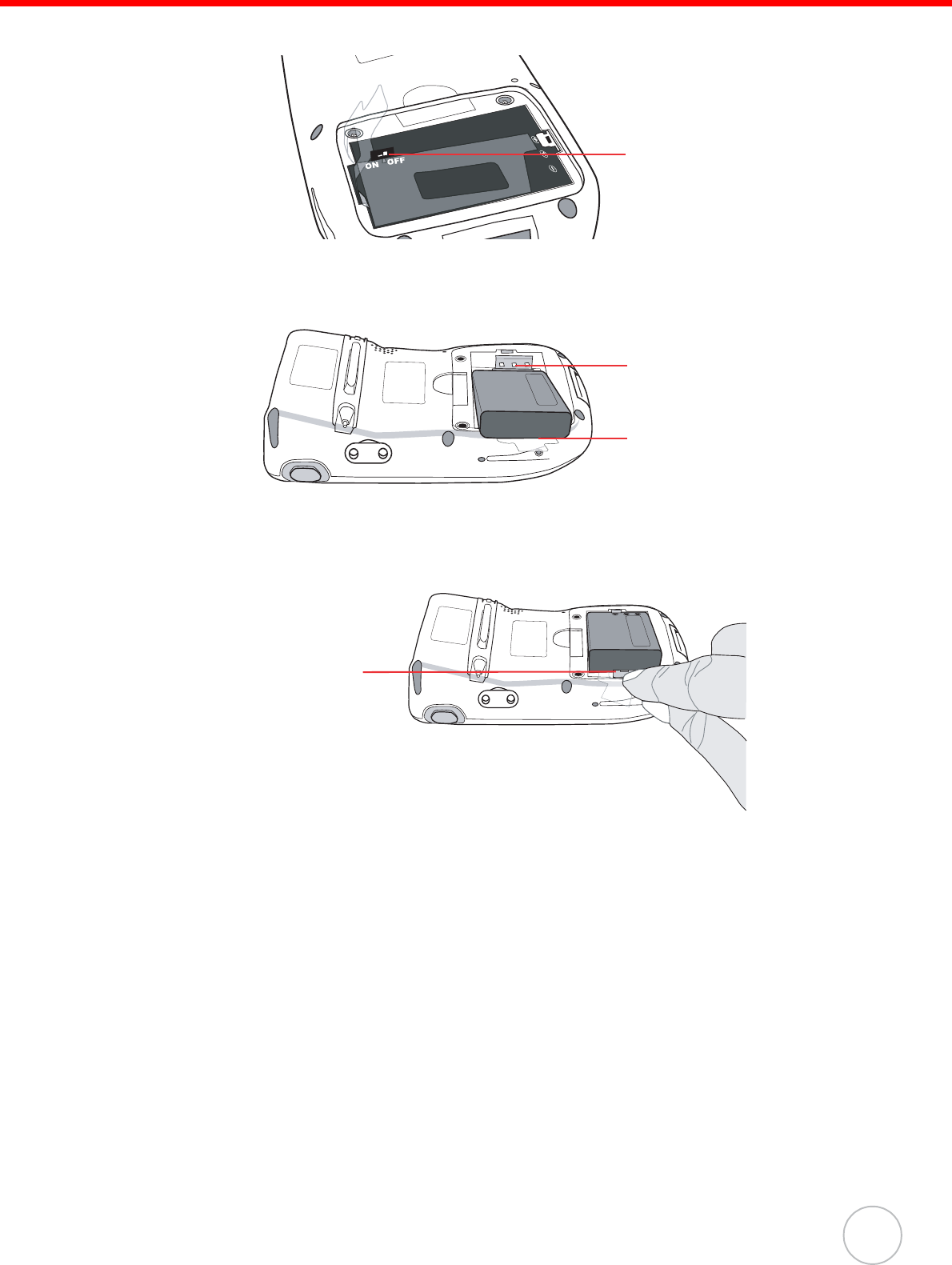
Chapter 1 Getting Started
7
2. Locate the backup battery switch and turn it on.
3. Position the battery pack, making sure the battery contacts are aligned with the
contacts in the compartment and the battery is placed on top of the plastic tab,
as shown in the following illustration.
4. Slide the battery pack into the battery bay while simultaneously pulling the bat-
tery hook until the battery clicks into place.
5. Replace the battery compartment cover.
Backup battery
switch
Contacts
Plastic tab
Battery hook
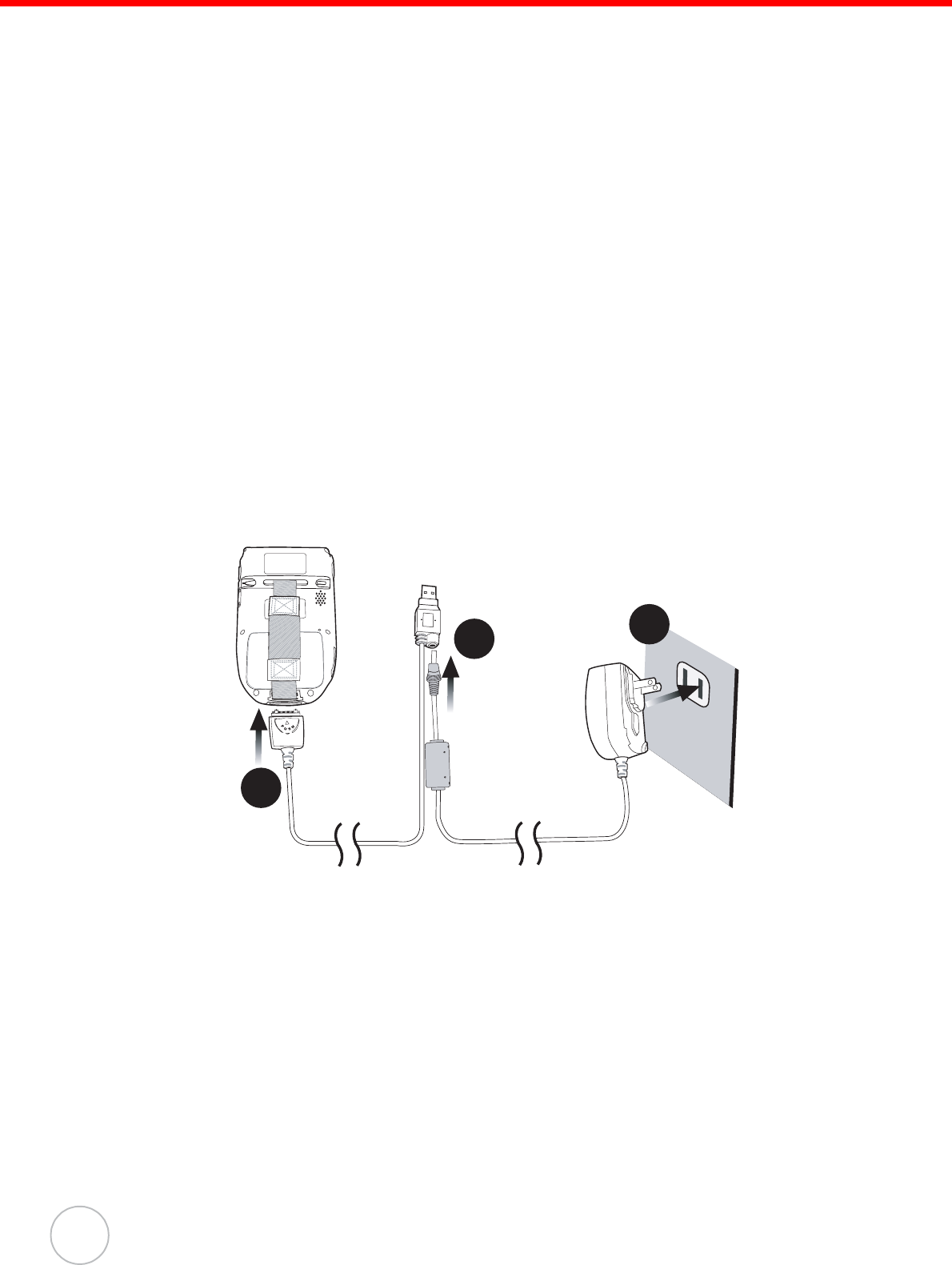
Chapter 1 Getting Started
8
Copyright 2008 unitech Electronics Co., Ltd. All rights reserved. unitech is a registered trademark of unitech Electronics Co., Ltd.
Charging the Battery
Before using the PA600 II for the first time, you need to charge it for about 16 hours.
After that, you can charge the PA600 II 4 hours to recharge the battery to full capacity.
Charge the PA600 II using the USB charging cable or the docking station.
CAUTION! Operating the PA600 II for the first time without the AC adapter, and
without fully charging the backup battery may result in loss of data
stored in RAM memory. When the main battery is removed, the
backup battery retains RAM data in memory for 2 hours, please
charge the battery for the period to avoid the data loss in RAM mem-
ory.
NOTE: Turn the backup battery switch on before charging the battery. Data you
entered may not be properly stored until the built-in backup battery has
been adequately charged.
Charging the Battery using the USB Cable
1. Press and hold the connector button on the USB charging cable and connect it
to the PA600 II (1).
2. Plug the AC adapter cable into the power jack on the USB charging cable (2).
3. Connect the AC adapter into an electrical outlet (3).
3
2
1
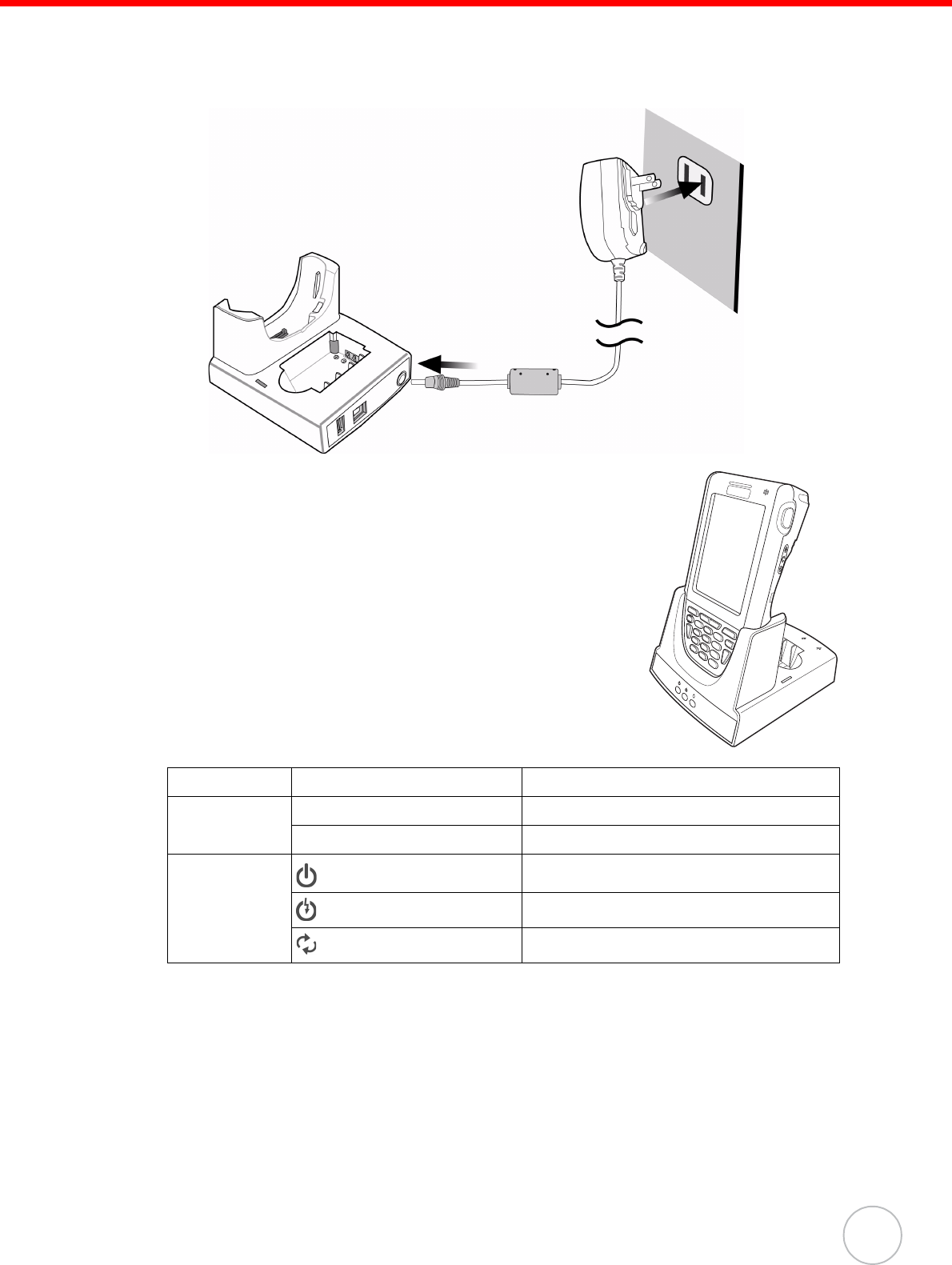
Chapter 1 Getting Started
9
Charging the Battery with the Docking Station
1. Plug the AC adapter cable into the power jack on the docking station, then con-
nect the AC adapter into an electrical outlet.
2. Slide the device into the docking station until it clicks
into place.
3. The connection is secure when the bottom edge of the
device is aligned with the docking station, and the LED
indicator on the device lights up red.
Checking the Battery Status
If the battery level becomes low in the course of normal use, a status icon appears on the
device screen indicating low or very low battery status. In both cases, perform an Active-
Sync operation to back up your data, then recharge your device as soon as possible.
If the battery level reaches low status, the device will enter a sleep mode and cannot
be powered up until the battery is charged. Windows Mobile 5.0 devices will retain
installed applications and data when the main battery is completely drained for
extended periods of time.e
LED Status
LED Meaning
PA600 II Solid Red Charging
Solid Green Charging complete
Docking
Station
Power LED Power is on
Charging LED: Charging (For spare battery only)
Sync LED Synchronization is taking place
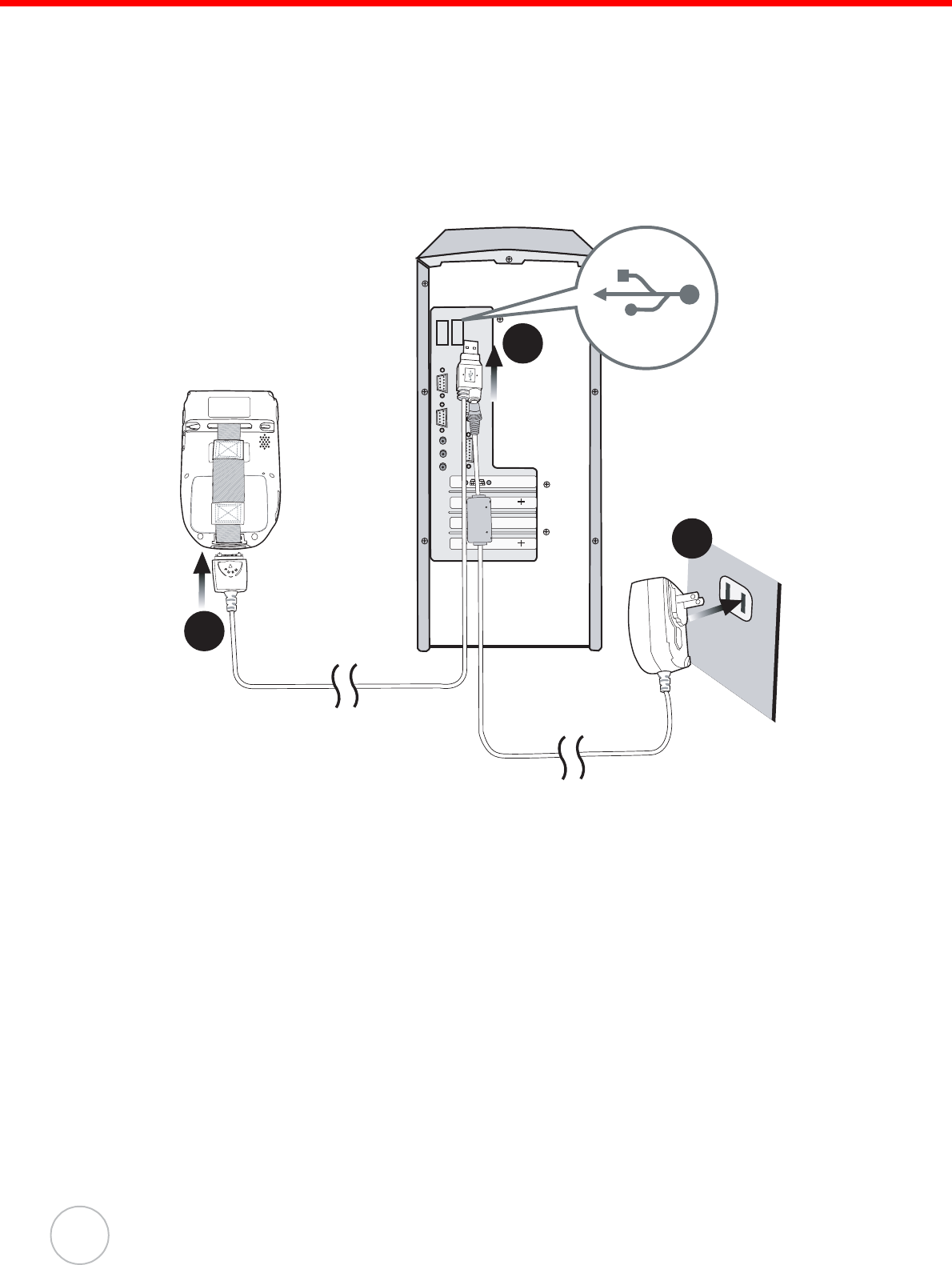
Chapter 1 Getting Started
10
Copyright 2008 unitech Electronics Co., Ltd. All rights reserved. unitech is a registered trademark of unitech Electronics Co., Ltd.
Connecting the PA600 II to a PC
Use the USB cable to connect the PA600 II to a PC, in order to use with ActiveSync.
1. Press and hold the connector button on the USB charging cable and connect it
to the PA600 II (1).
2. Plug the USB connector into the USB port on the PC and connect the AC
adapter into the USB connector (2).
3. Connect the AC adapter into an electrical outlet (3).
3
2
1
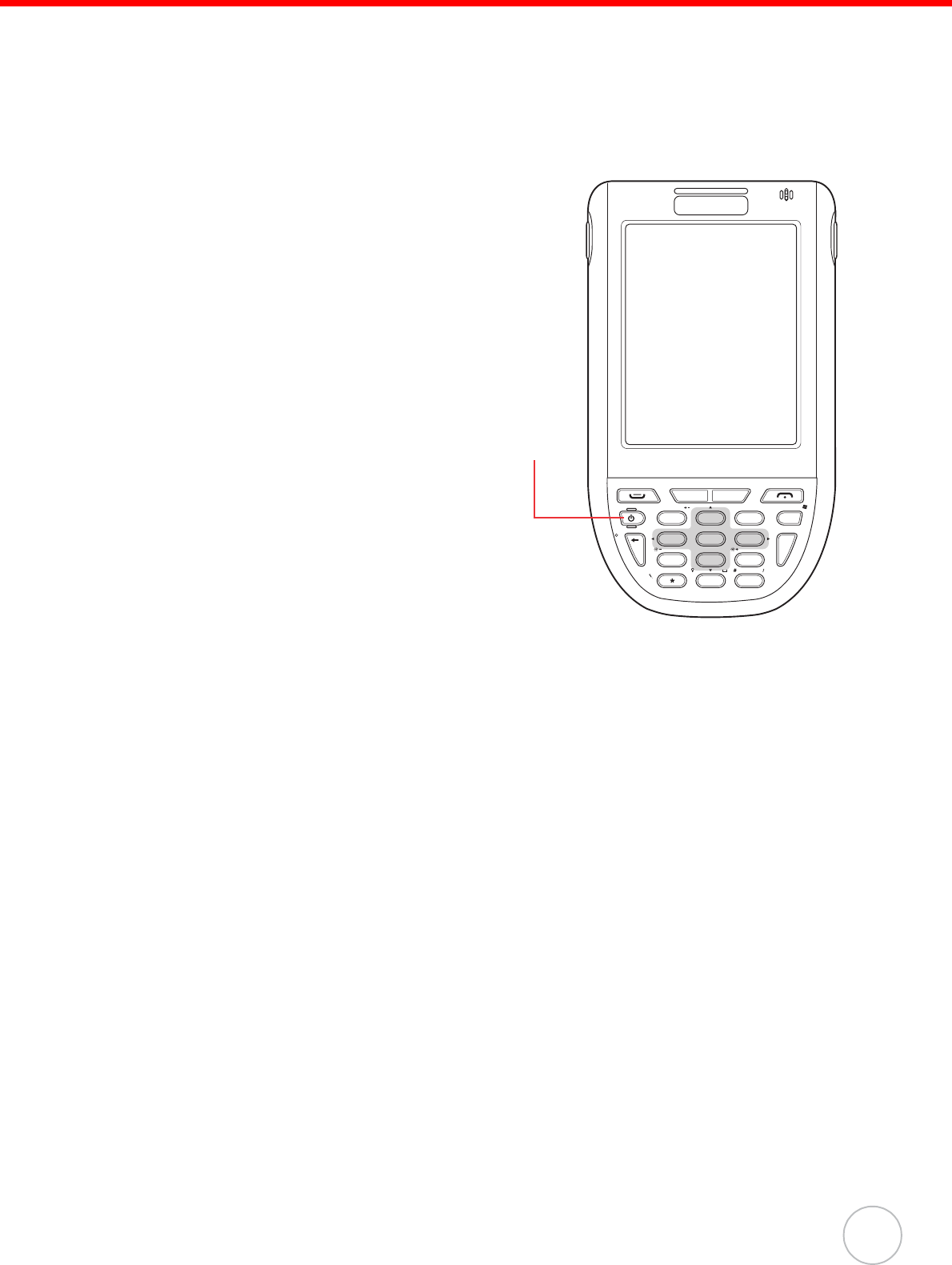
Chapter 1 Getting Started
11
Turning the PA600 II on for the First Time
After you have initially charged your device for about 16 hours, the device is ready to
be used. You can now start up your device where you’ll calibrate the display, learn
some basic stylus usage, and set up the system time zone, date and time.
Powering On
1. Turn on your device by pressing
the power button on the front panel.
NOTE: The PA600 II screen ships
with a protective plastic film.
You may remove this if
desired by peeling from one
corner. The screen will be
more susceptible to scratch-
ing without the film, but will be
more readable.
2. The unitech PA600 II welcome
screen appears for a moment fol-
lowed by the Windows Mobile
screen. FUNC
Ls
ESC ghi jkl mno
wxyz
ENTER
TAB
tuvpqrs
key
OK
abc Rs def
ALPHA
1
4
7
2
5
8
0
3
6
9
.
Power Button
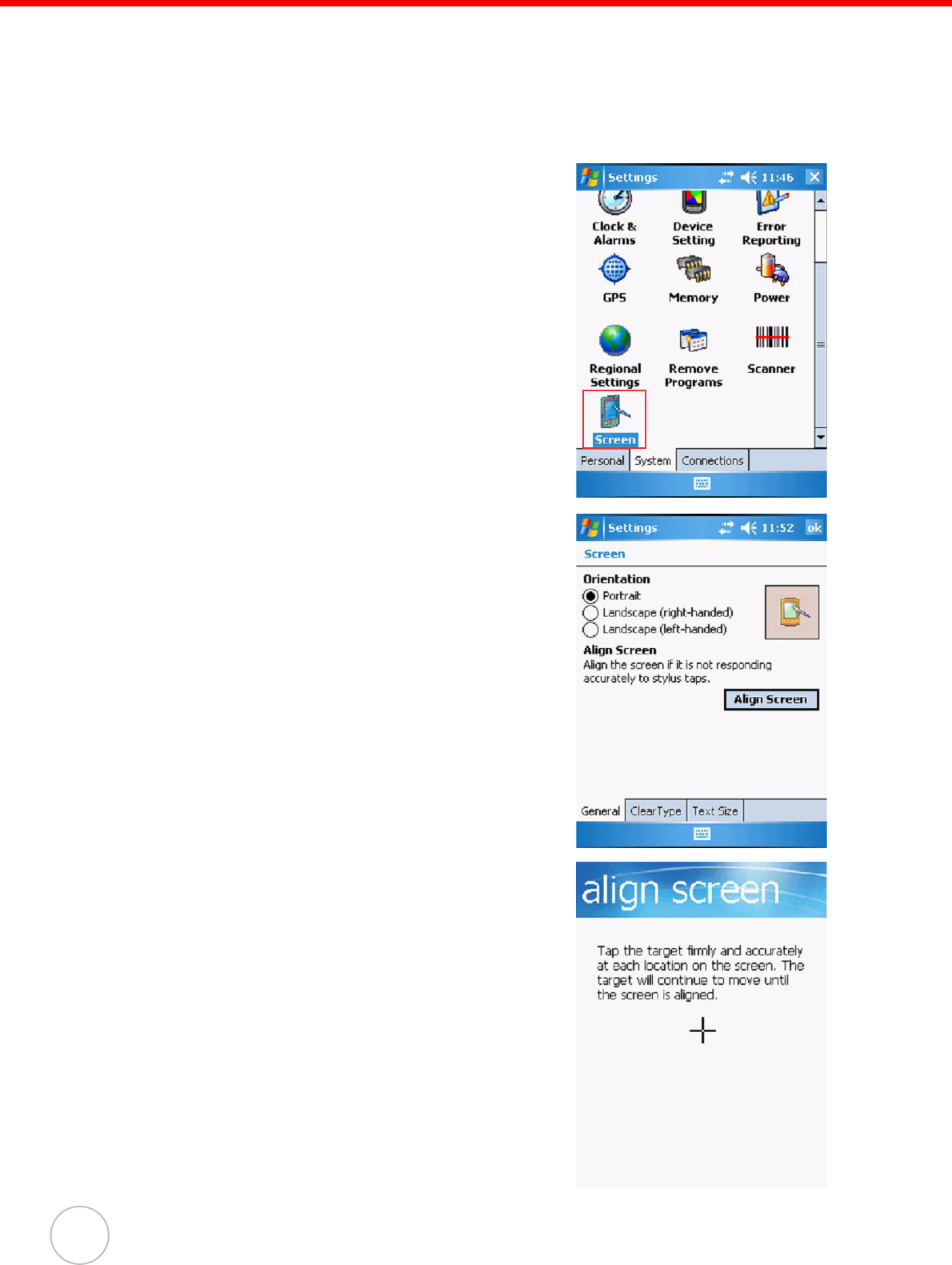
Chapter 1 Getting Started
12
Copyright 2008 unitech Electronics Co., Ltd. All rights reserved. unitech is a registered trademark of unitech Electronics Co., Ltd.
Calibrating the PA600 II Screen
The calibrate screen automatically appears when the unit is powered-on for the first
time or after the system is reset.
To calibrate the screen at any time, follow these instructions.
1. Tap Start → Settings, and then switch to System tab.
2. Tap the Screen icon.
Or
Press Func key and ESC key simultaneously.
The Screen Settings window appears.
This Window enables you to customize the screen
settings.
3. Tap Align Screen to calibrate the screen.
The align screen window appears.
4. Tap the cross hair firmly and accurately.
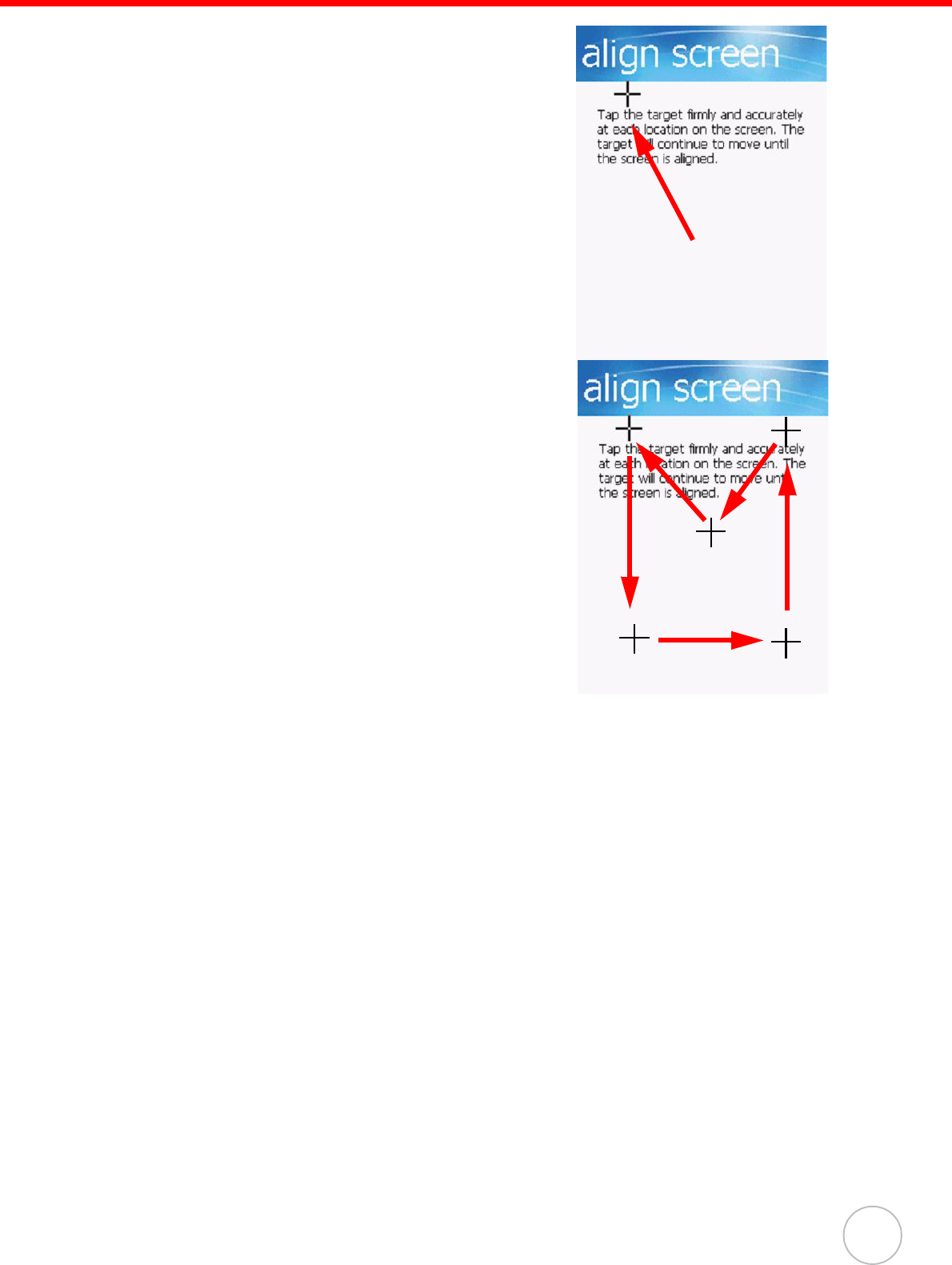
Chapter 1 Getting Started
13
The cross hair moves to the next location.
5. Continue tapping the cross hairs until the
screen has been calibrated.
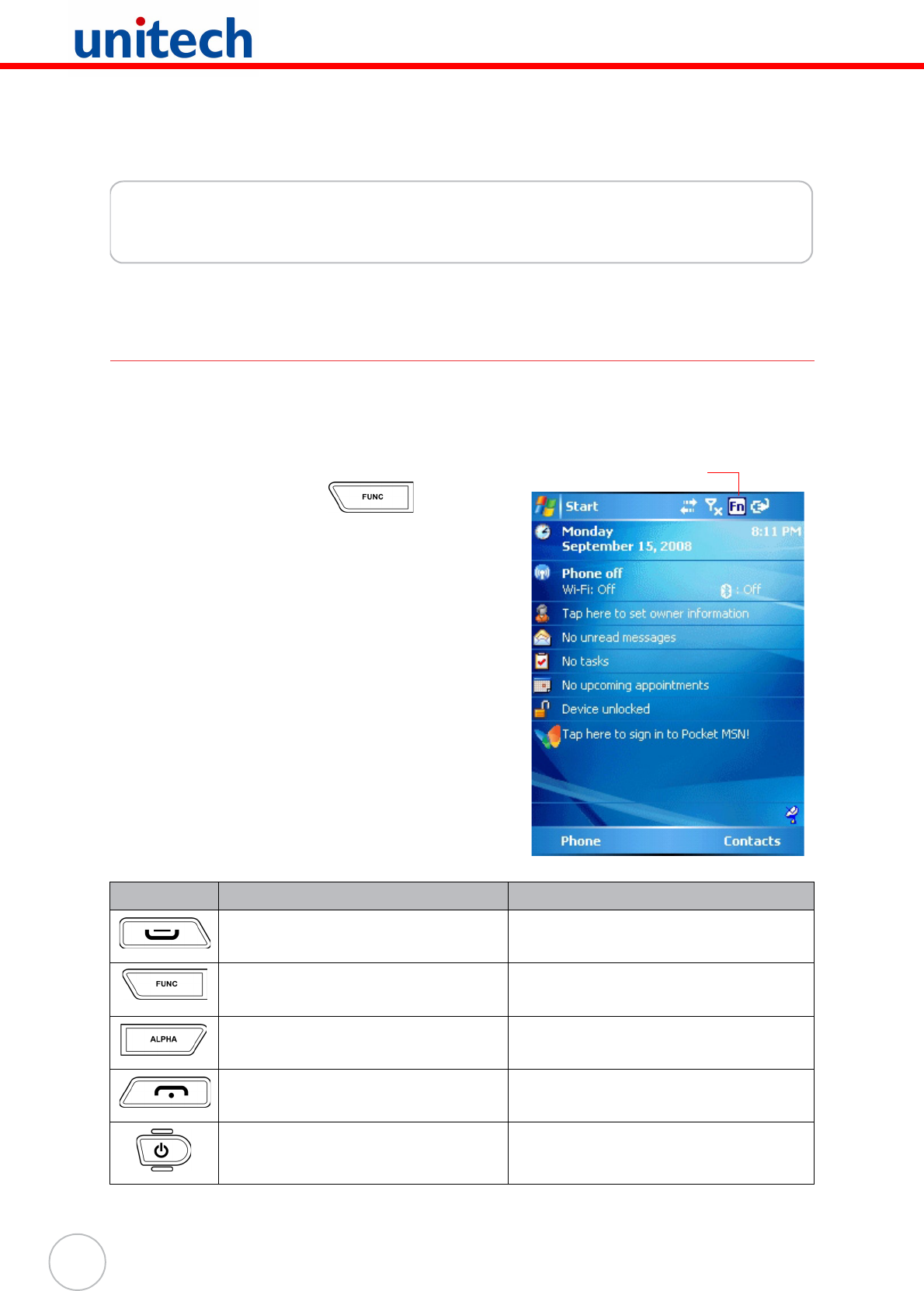
14
Copyright 2008 unitech Electronics Co., Ltd. All rights reserved. unitech is a registered trademark of unitech Electronics Co., Ltd.
Chapter 2
Using the Hardware
Keypads and Function Buttons
The keypad enables you to both enter information and interact with the PDA operating
system and also operate secondary functions using the function button. When the
green function button is pressed, the green icon functions on the keypad become
available.
When the Function button is pressed,
an icon appears in the operating system:
The following table describes the keypad keys.
Key Main Function Secondary Function
Talk/Send Opens Phone screen to make a
call or send a message
—Enables/ disables secondary
function keys
Alpha —
End Exits Phone screen or ends a call
Turns the PA600 II on and off. —
Function activated icon
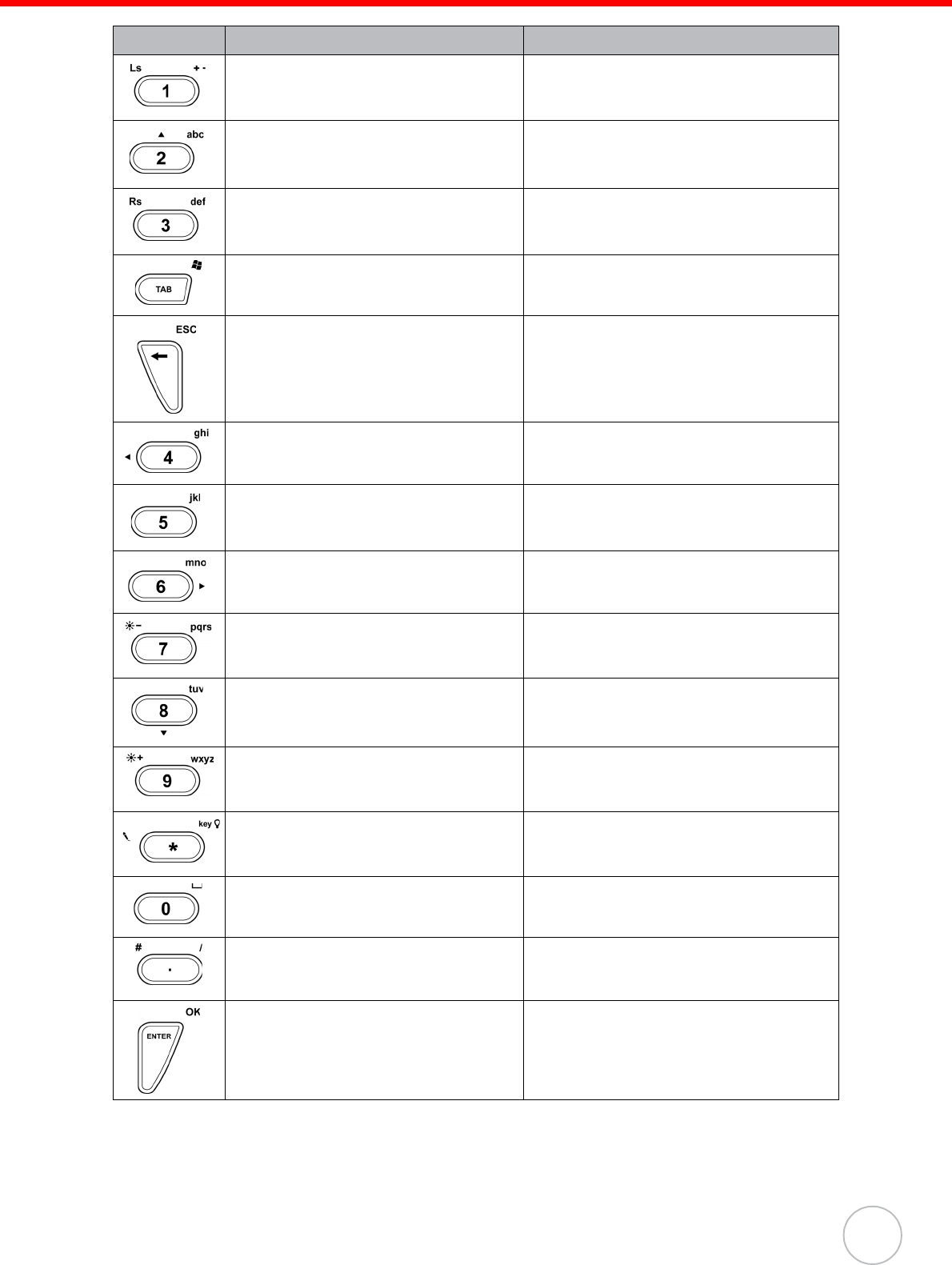
Chapter 2 Using the Hardware
15
Number 1 Left soft key - activates function
above in LCD screen.
Alphanumeric 2, a, b, c Up navigation key
Alphanumeric 3, d, e, f Right soft key - activates function
above in LCD screen.
Tab Windows key opens Start menu
Back space Escape key
Alphanumeric 4, g, h, i Left navigation key
Alphanumeric 5, j, k, l —
Alphanumeric 6, m, n, o Right navigation key
Alphanumeric 7, p, q, r, s Decreases screen brightness
Alphanumeric 8, t, u, v Down navigation key
Alphanumeric 9, w, x, y, z Increases screen brightness
Asterisk Illuminates keypad
Number 0, space —
Period Pound
Enter key OK
Key Main Function Secondary Function
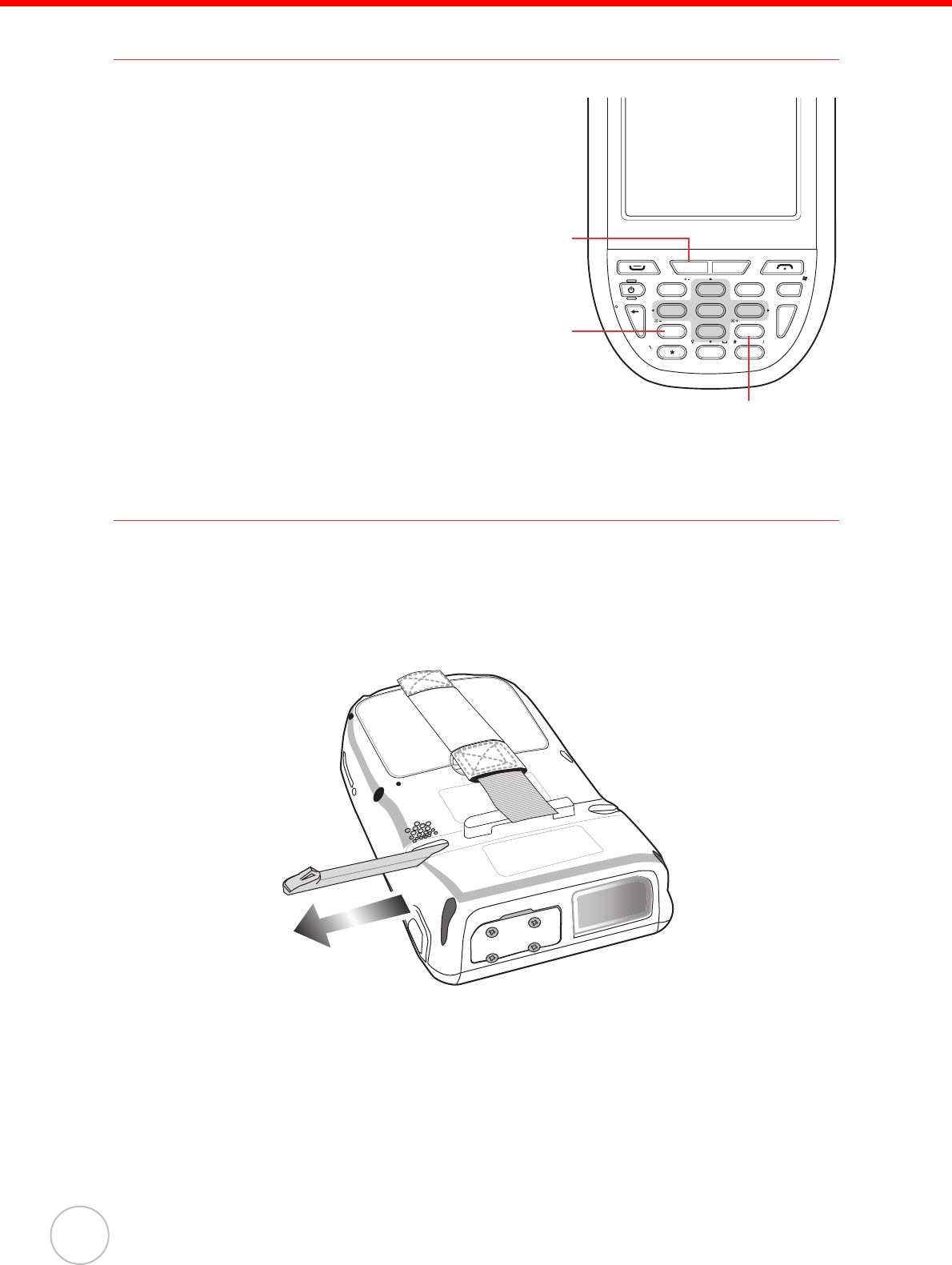
Chapter 2 Using the Hardware
16
Copyright 2008 unitech Electronics Co., Ltd. All rights reserved. unitech is a registered trademark of unitech Electronics Co., Ltd.
Adjusting the Screen Brightness
Adjust the screen brightness by pressing
the Function button to enable the soft
keys and pressing the 7 (decrease bright-
ness) or 9 (increase brightness) buttons.
Using the Stylus
CAUTION! Never use anything other than the PA600 II stylus on the screen. Oth-
erwise this could cause a permanent damage.
1. Remove the stylus from its holder.
2. Hold the stylus as you hold a pencil.
3. To make a choice from a menu, lightly tap the tip of the stylus on that choice.
4. To write data into a field on a form, use the stylus to print the letters or numbers.
Use very light pressure.
FUNC
Ls
ESC ghi jkl mno
wxyz
ENTER
TAB
tuvpqrs
key
OK
abc Rs def
ALPHA
1
4
7
2
5
8
0
3
6
9
.
Function
Button
Increase
Brightness
Decrease
Brightness
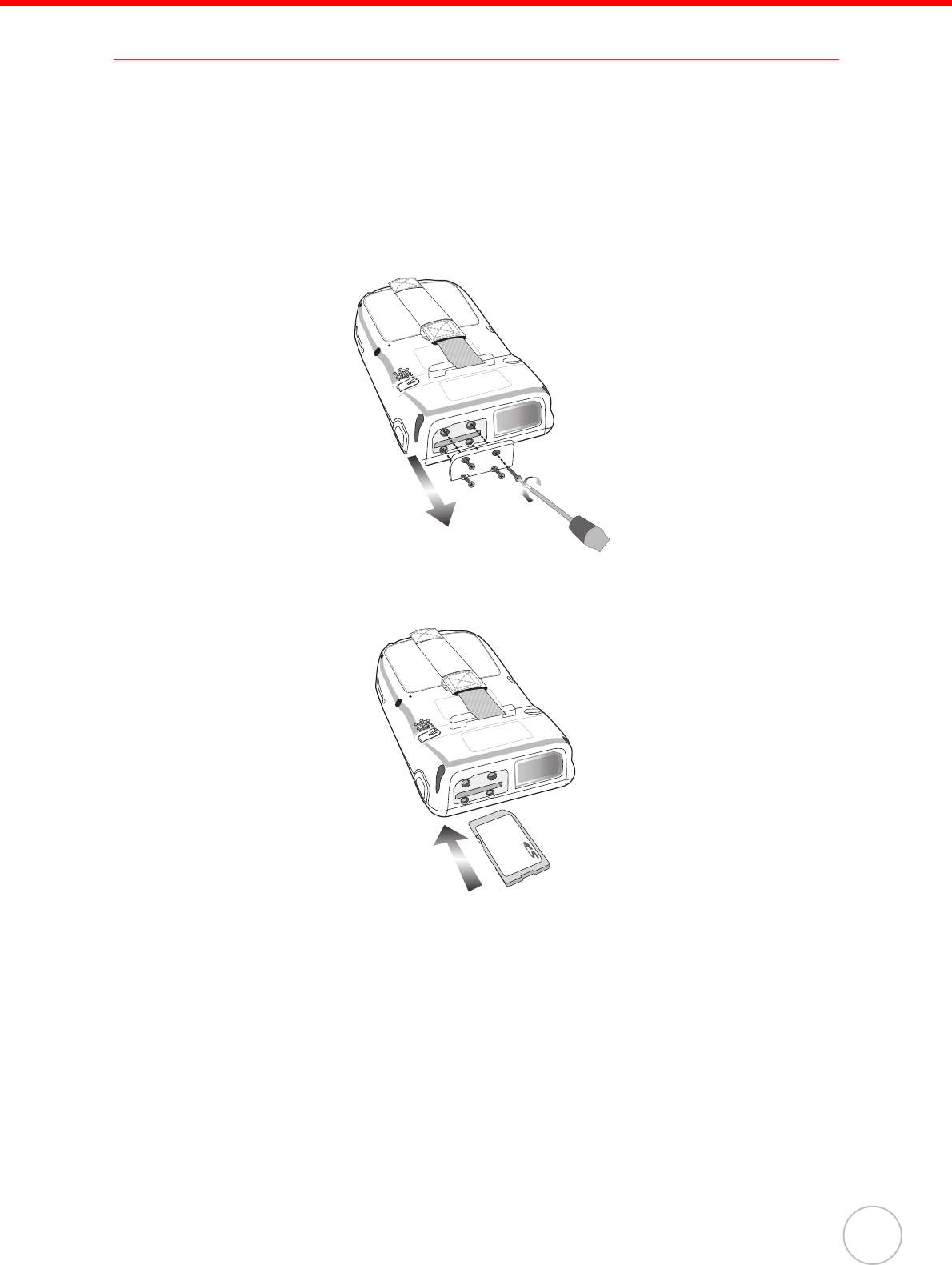
Chapter 2 Using the Hardware
17
Using the SD/MMC memory card
Your device has an expansion slot compatible with a range of SD and MMC storage
cards, which are primarily used to back up or transfer files and data. The slot also sup-
ports SDIO cards for added connectivity options.
Inserting a Storage Card
1. Remove the four screws from the SD compartment cover and remove the
cover.
2. Insert the SD card with the notched corner as shown by the icon on the case.
3. Replace the SD compartment cover and the four compartment screws.
Removing a Storage Card
1. Remove the four screws from the SD compartment cover and remove the
cover.
2. Press the card in and release.
The card pops out.
3. Remove the card from the slot.
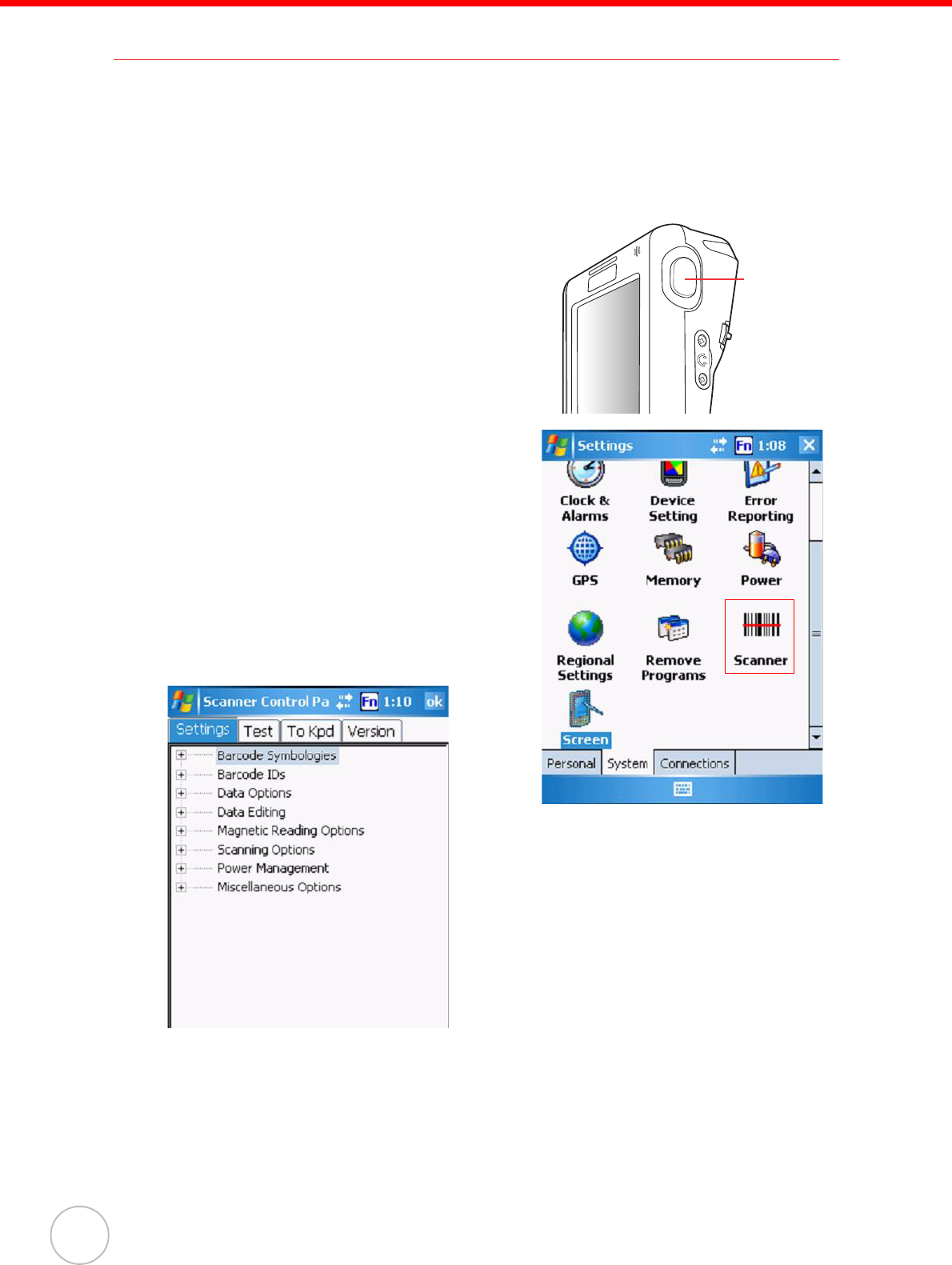
Chapter 2 Using the Hardware
18
Copyright 2008 unitech Electronics Co., Ltd. All rights reserved. unitech is a registered trademark of unitech Electronics Co., Ltd.
Using the Laser Scanner
The PA600 II has an integrated laser scanner which reads all major bar code labels
with excellent performance.
NOTE: Scanning software must be enabled in order to operate the scanner.
This can be a user-loaded application or a pre-loaded utility such as
Scanner Setting and Scan2Key.
Activate the laser scanner by pressing either one
of the trigger keys located on the left and right side
of the unit.
The PA600 II has a built-in Scanner Setting utility
that allows you to test the device’s barcode scan
function.
1. To launch Scanner Settings, tap Start →
Settings, and then switch to System tab.
Tab the Scanner icon.
2. The Scanner Control Panel opens.
From here you can configure barcode scanner parameters such as enabling or
disabling barcode symbologies, setting data transmission options, configuring
magnetic and proximity reading options, and setting power management
options.
Scan button
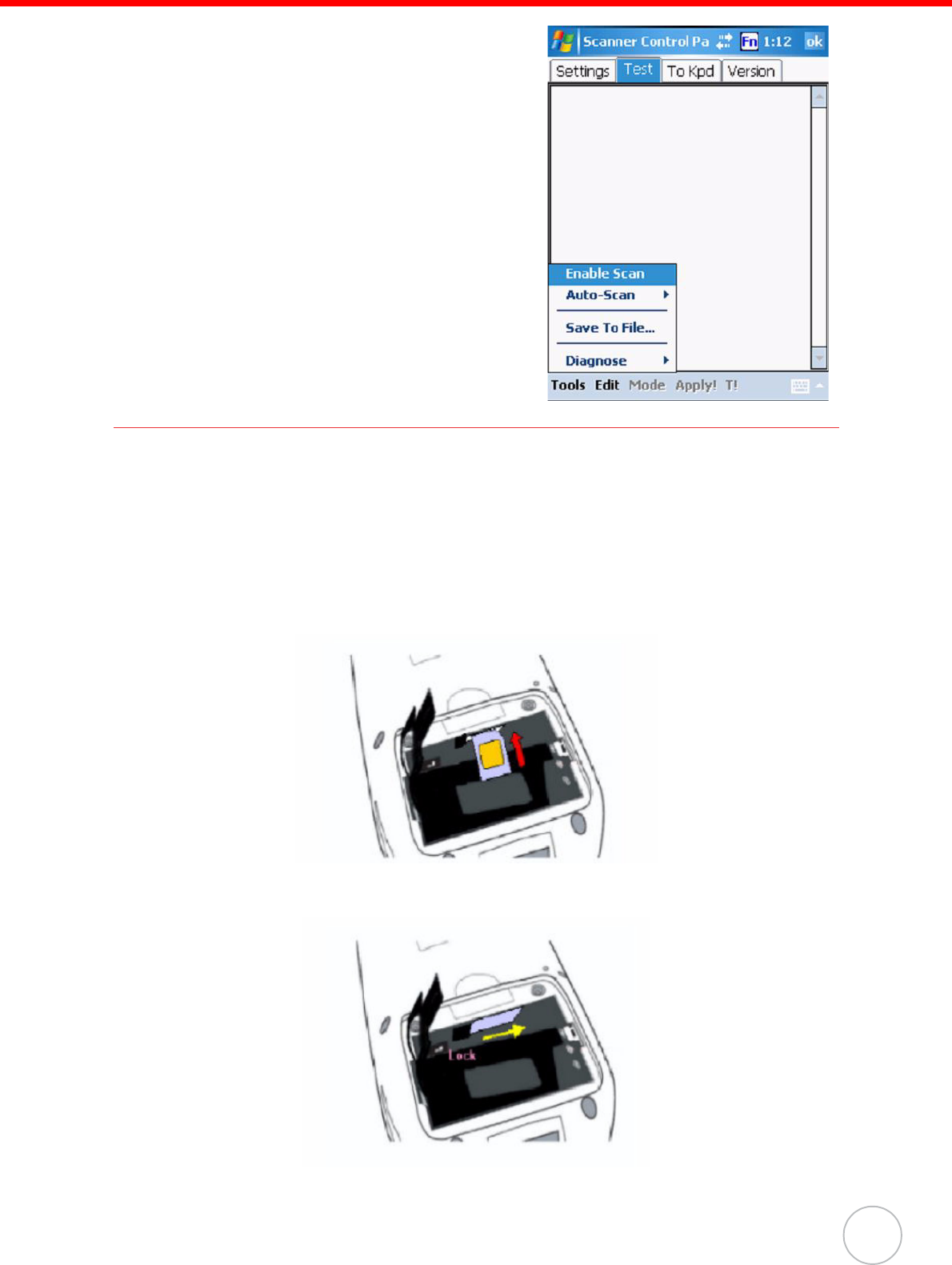
Chapter 2 Using the Hardware
19
3. To test the barcode scanner, tap the Test
tab.
4. Tap Tools
5. Tap Enable Scan
6. To perform auto scan, Tap Tools → Auto
Scan → Start Auto- Scan
7. Choose Interval: 3 secs
8. Tap: Start
9. Laser scans every 3 seconds and barcode
is scanned automatically.
10. Tap Tools → Auto-Scan → Stop Auto-
Scan.
Using the SIM Card
The PA600 II has a slot for GPRS SIM card. It is placed inside the battery compart-
ment.
Inserting the SIM Card
1. Take out the battery cover and the main battery. Insert the SIM card with the
notched corner as shown in the picture below.
NOTE: The chip of the SIM card should face upwards.
2. Push the SIM card to the end until you hear a click. Push the lock to the right to
lock the card by stylus.
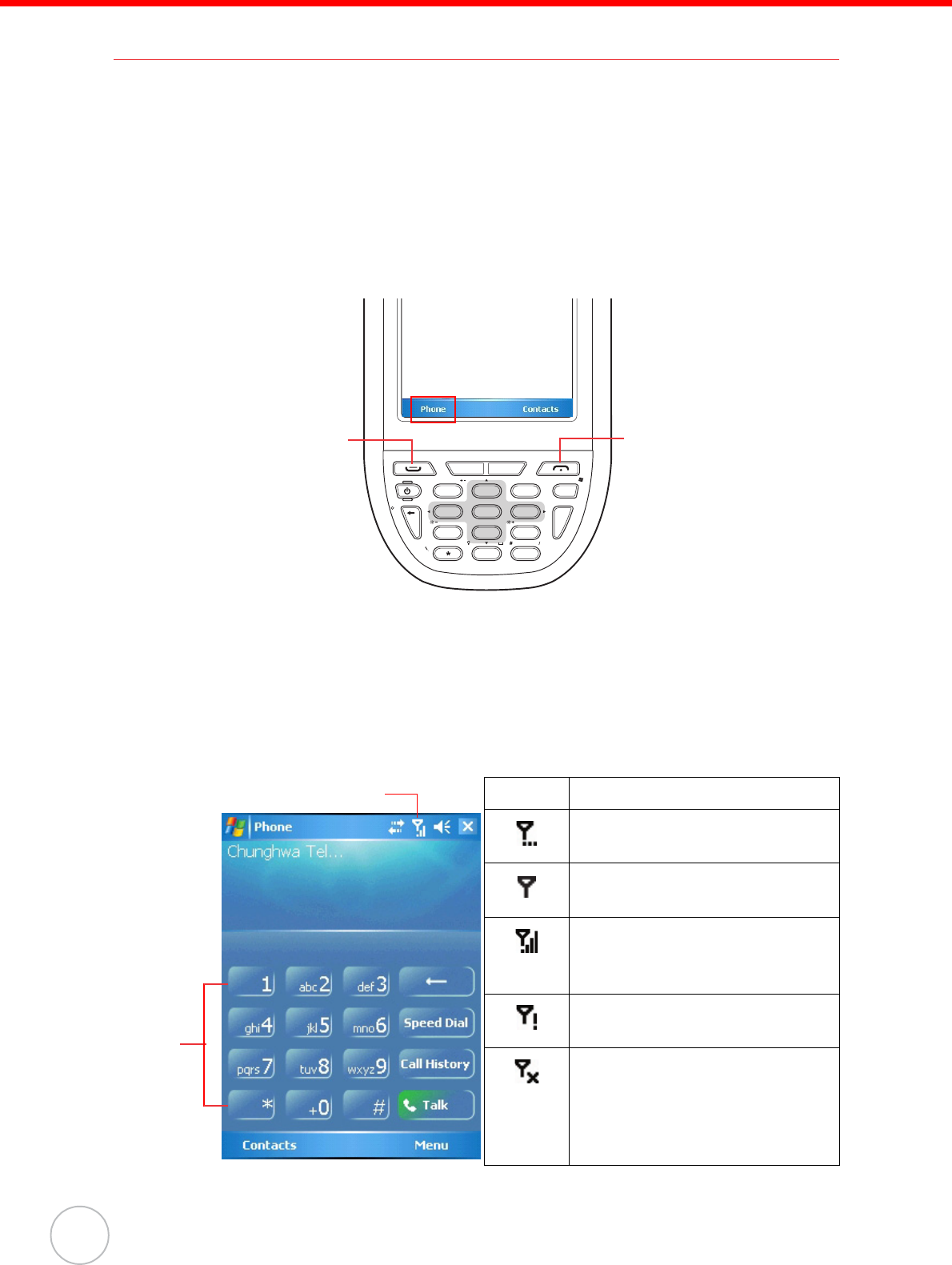
Chapter 2 Using the Hardware
20
Copyright 2008 unitech Electronics Co., Ltd. All rights reserved. unitech is a registered trademark of unitech Electronics Co., Ltd.
Using the Phone
The PA600 II has an integrated phone keypad, which allows you to make, receive,
and send messages via the built-in module.
NOTE: Make sure you insert the SIM card properly.
To open the Phone screen, do one of the following.
1. Tap Phone on the bottom left corner of the screen.
2. Press Talk/Send button.
Press End button when you want to exit the Phone screen.
The Phone screen opens. From here you can manage the contact list, create speed
dials, messages, notes, and customize phone settings.
NOTE: If you SIM card is protected by a PIN code, input the password before
you can use the phone.
Tap the antenna signal icon on the upper right corner of the screen. Tap Wireless
Manager and turn on phone function.
Signal Description
Phone service searching
No signal is available.
Strongest signal strength
More bars you have, the
stronger signal you have.
No phone service provided.
Phone function is turned off.
Tap the antenna signal icon
and turn on phone function in
the Wireless Manager.
FUNC
Ls
ESC ghi jkl mno
wxyz
ENTER
TAB
tuvpqrs
key
OK
abc Rs def
ALPHA
1
4
7
2
5
8
0
3
6
9
.
Talk/Send
button
End
button
Phone
keypad
Antenna signal icon
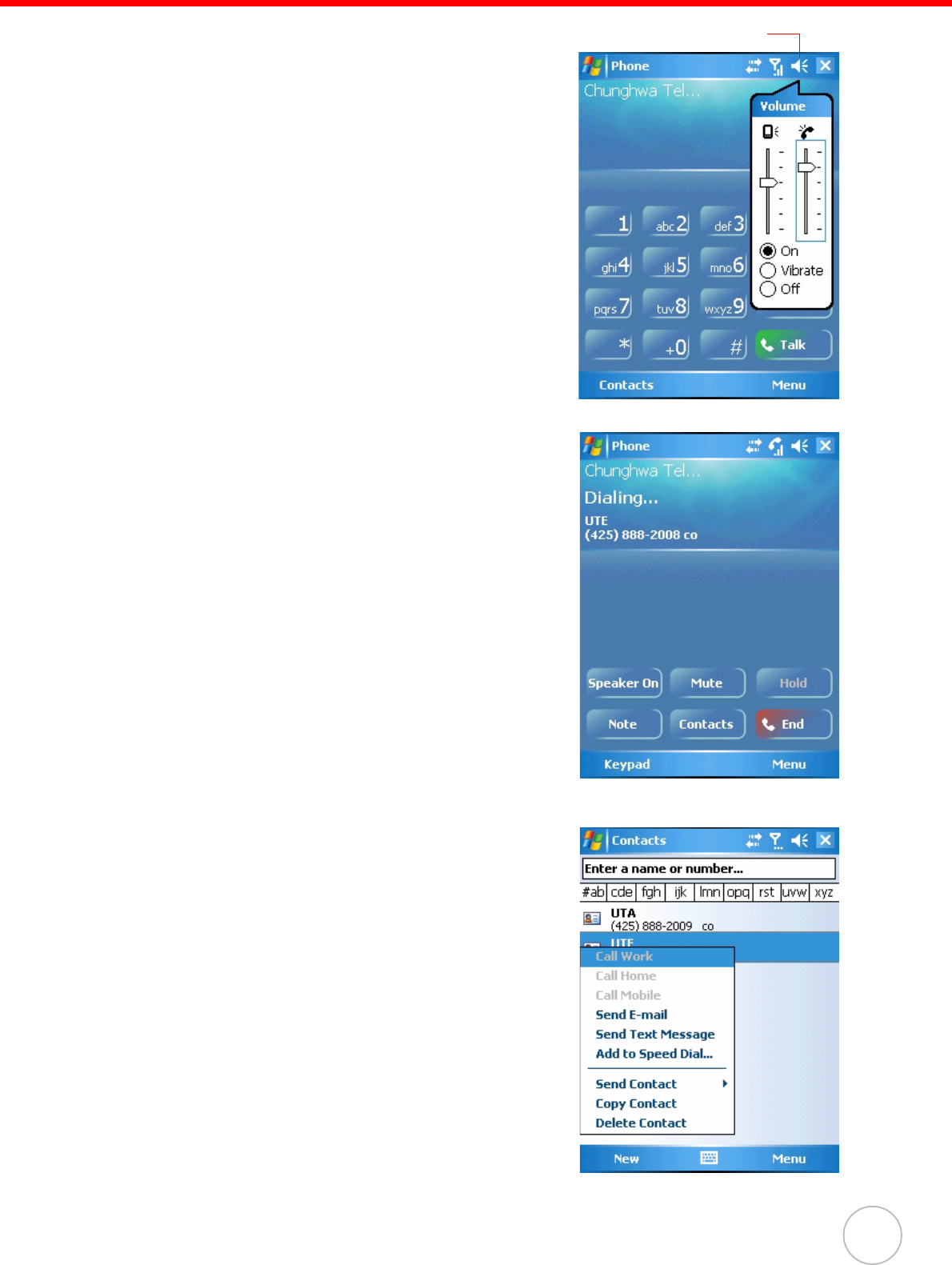
Chapter 2 Using the Hardware
21
Tap the speaker icon on the upper right corner of
the screen. You can adjust the device/ phone vol-
ume by moving the sliders and change the ring
volume by tapping On, Vibrate, or Off.
Making a Call Using the Phone Keypad
1. Tap Phone or press Talk/Send button.
2. Enter the desired phone numbers.
3. Tap the Talk button on the Phone screen.
4. When the call connects, you can tap Hold
to place the first number on hold.
5. Enter the second phone numbers and tap
Talk again.
6. Tap Swap to switch between calls.
7. Tap End or press End button to stop dialing
or end the call.
Using the Contact List
1. Tap Contacts on the bottom left corner of
the Phone screen.
2. Tap New on the bottom left corner of the
contact list, you can add a new contact.
3. Tap a contact, you can edit the contact info.
4. Tap and hold on a contact, a menu
appears. You can send e-mail/ text mes-
sage to the contact, add this contact to
speed dial list, and so on.
Speaker icon
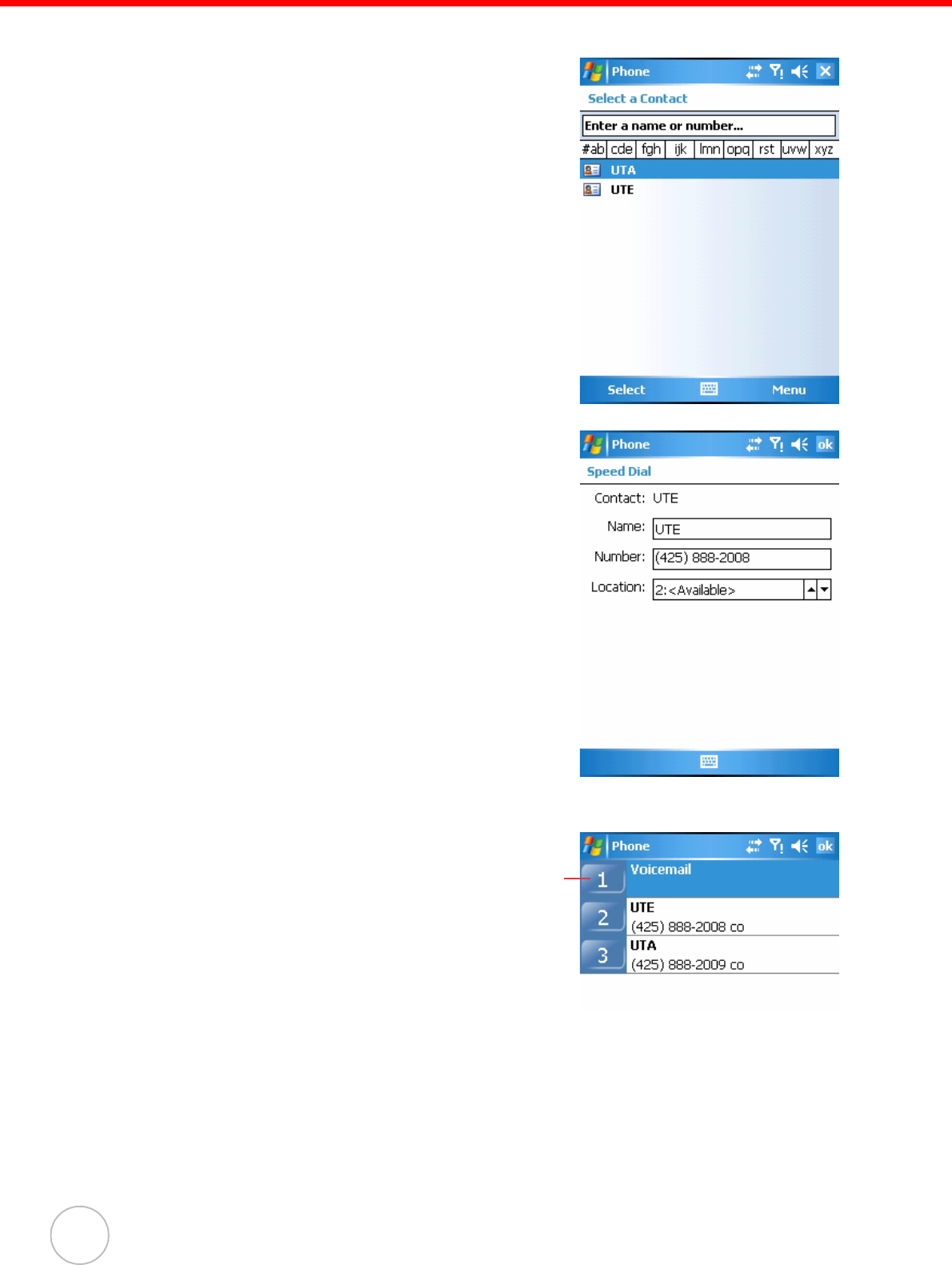
Chapter 2 Using the Hardware
22
Copyright 2008 unitech Electronics Co., Ltd. All rights reserved. unitech is a registered trademark of unitech Electronics Co., Ltd.
Using the Speed Dial
1. Tap Speed Dial on the Phone keypad.
2. Tap Menu, and select New.
3. Select a contact in your contact list by tap-
ping the desired contact.
4. Assign an available location for the new
speed dial entry. Tap OK, and then OK to
exit the speed dial list.
NOTE: The first speed dial location is
reserved for voice mail.
To make speed dial call, do one of the following.
1. Tap and hold the speed dial location
number assigned to a contact on the
Phone keypad.
2. Tap Speed Dial on the Phone keypad,
and tap the location number of the
desired speed dial entry.
Customizing the Phone Settings
Tap Menu, and select Options, you can change the default phone settings, including
ring sound, keypad sound, call barring, call forwarding, call waiting, mobile phone net-
work, etc.
Location
number
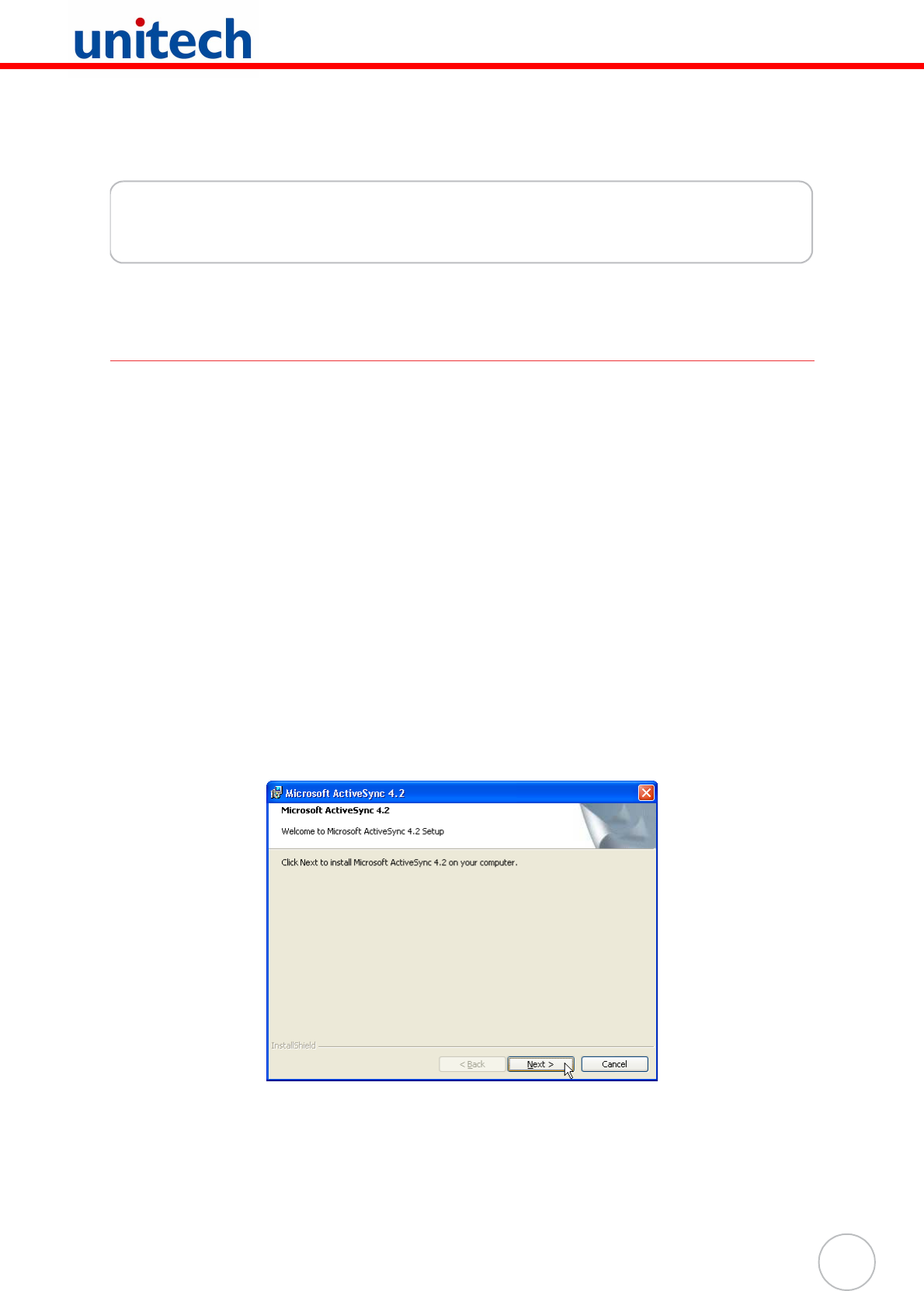
23
Chapter 3
Getting Connected
Establishing Device-PC Connection
Installing Microsoft ActiveSync
In order to exchange data between your computer and PA600 II, Microsoft ActiveSync
must be installed on your computer. Use the USB charging cable that comes with your
device to connect the device to your computer.
NOTE: If you have a previous version of the Microsoft ActiveSync installed in
your computer, uninstall it first before installing the latest version of
Microsoft ActiveSync.
To install Microsoft ActiveSync on your computer:
1. Close any open programs, including those that run at startup, and disable any
virus-scanning software.
2. Download the ActiveSync software from the Microsoft ActiveSync Download
page at
http://www.microsoft.com/windowsmobile/downloads/activesync42.mspx.
3. Browse the location of the downloaded file, and double-click it.
The installation wizard begins.
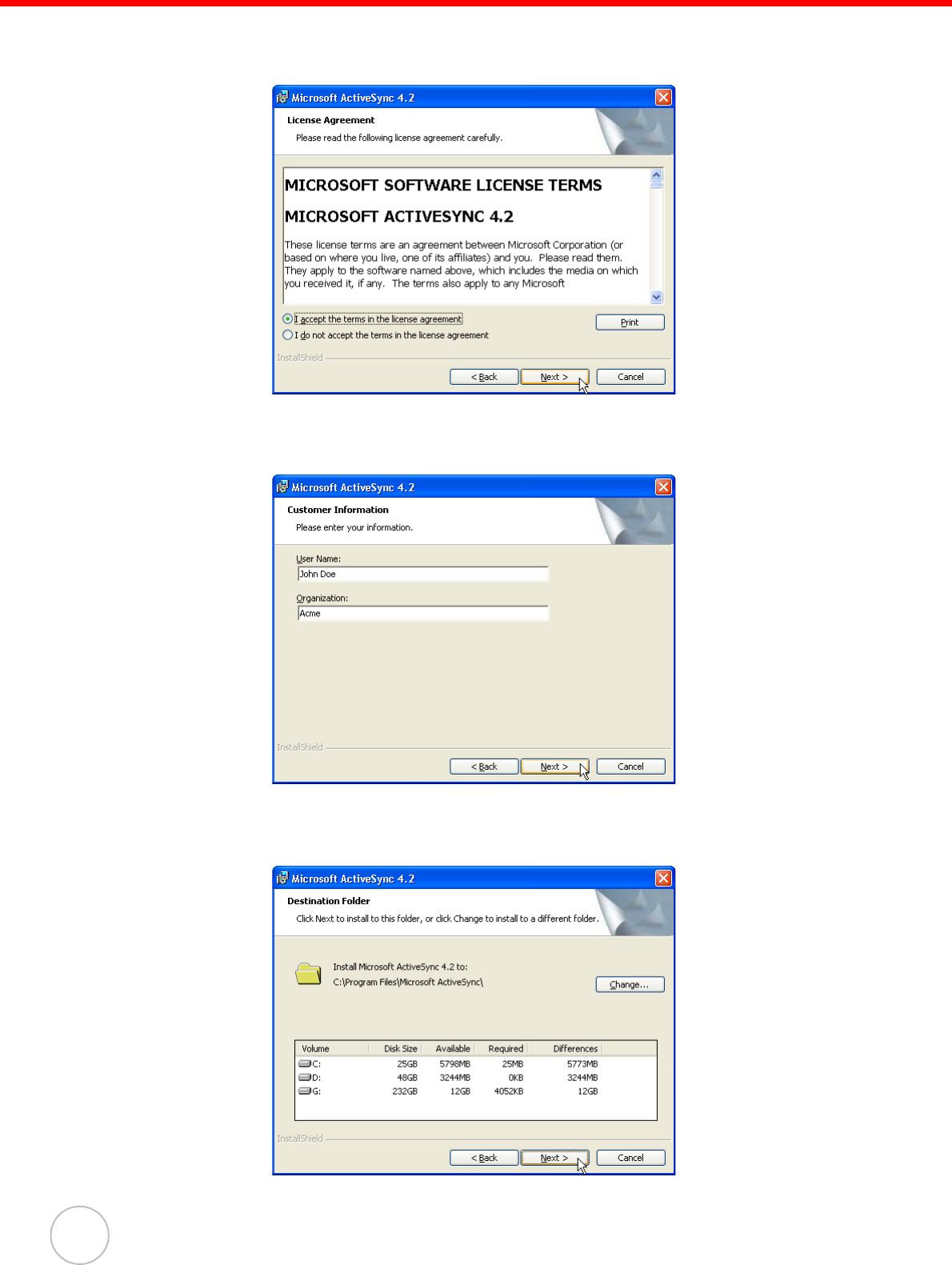
Chapter 3 Getting Connected
24
Copyright 2008 unitech Electronics Co., Ltd. All rights reserved. unitech is a registered trademark of unitech Electronics Co., Ltd.
4. Click Next.
You are prompted to read the End User License Agreement (EULA).
5. Accept the license agreement terms and click Next.
You are prompted for user information.
6. Type the user name and organization and click Next.
You are prompted for the destination folder.
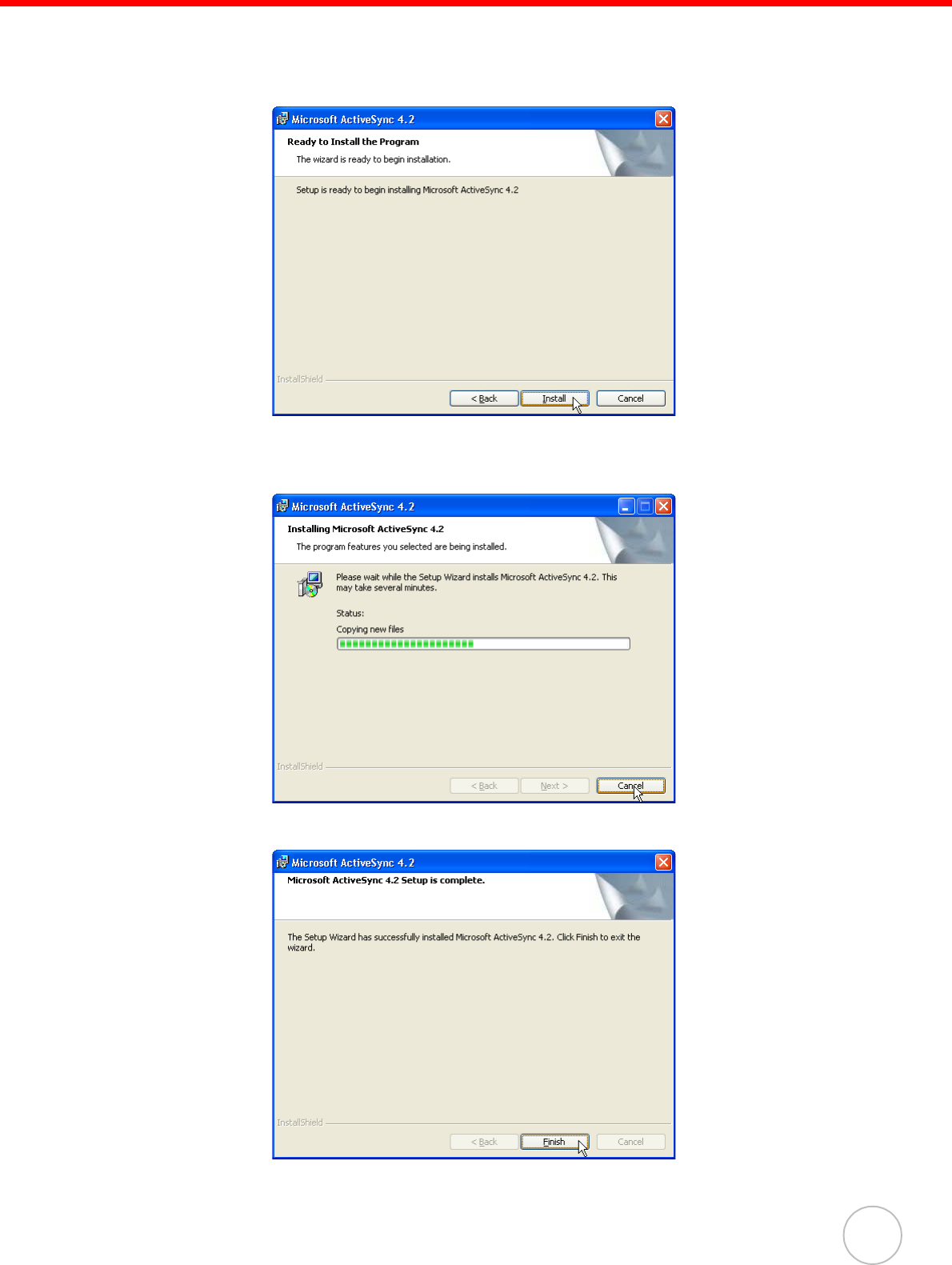
Chapter 3 Getting Connected
25
7. Select a drive to install the program and click Next.
The installation wizard has gathered the information it needs to install Active-
Sync and prompts you to begin the installation.
8. Click Install.
The program begin the installation
After the program has finished installing you see the following screen.